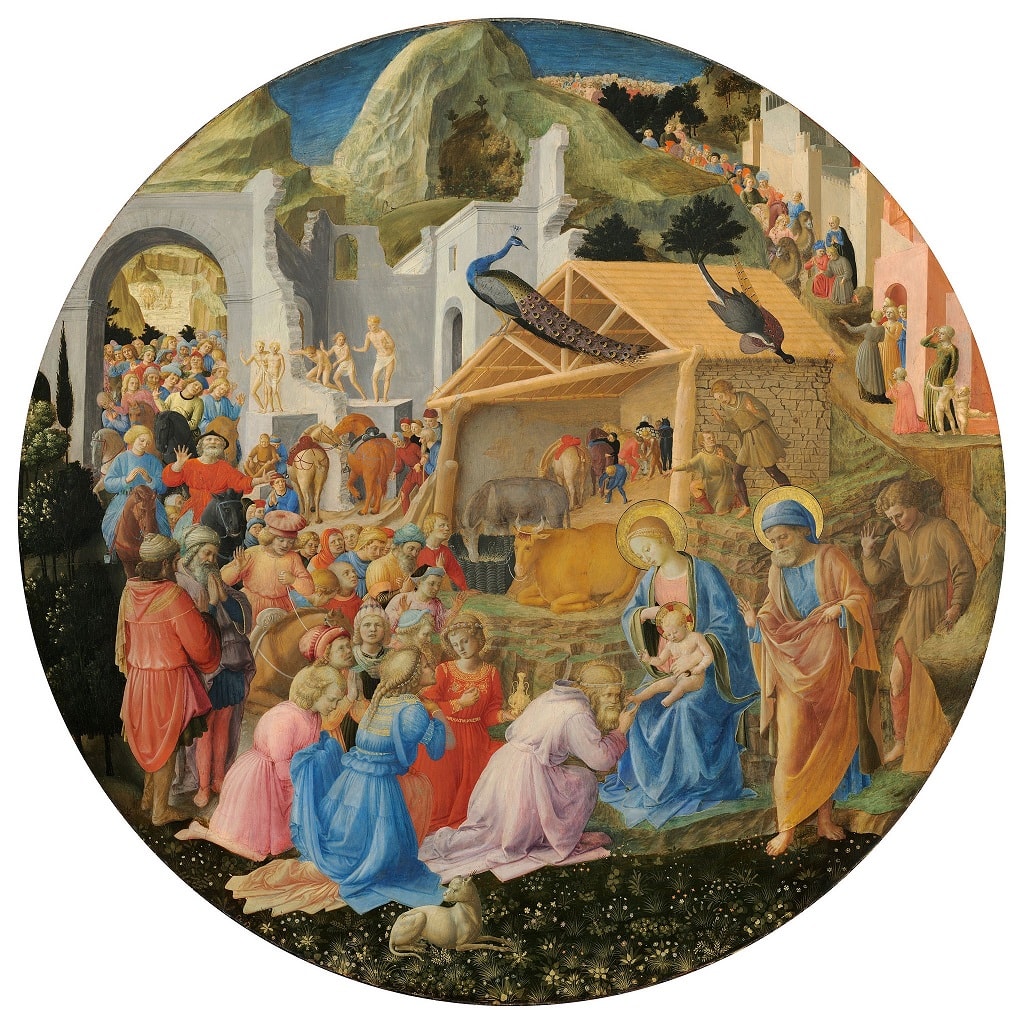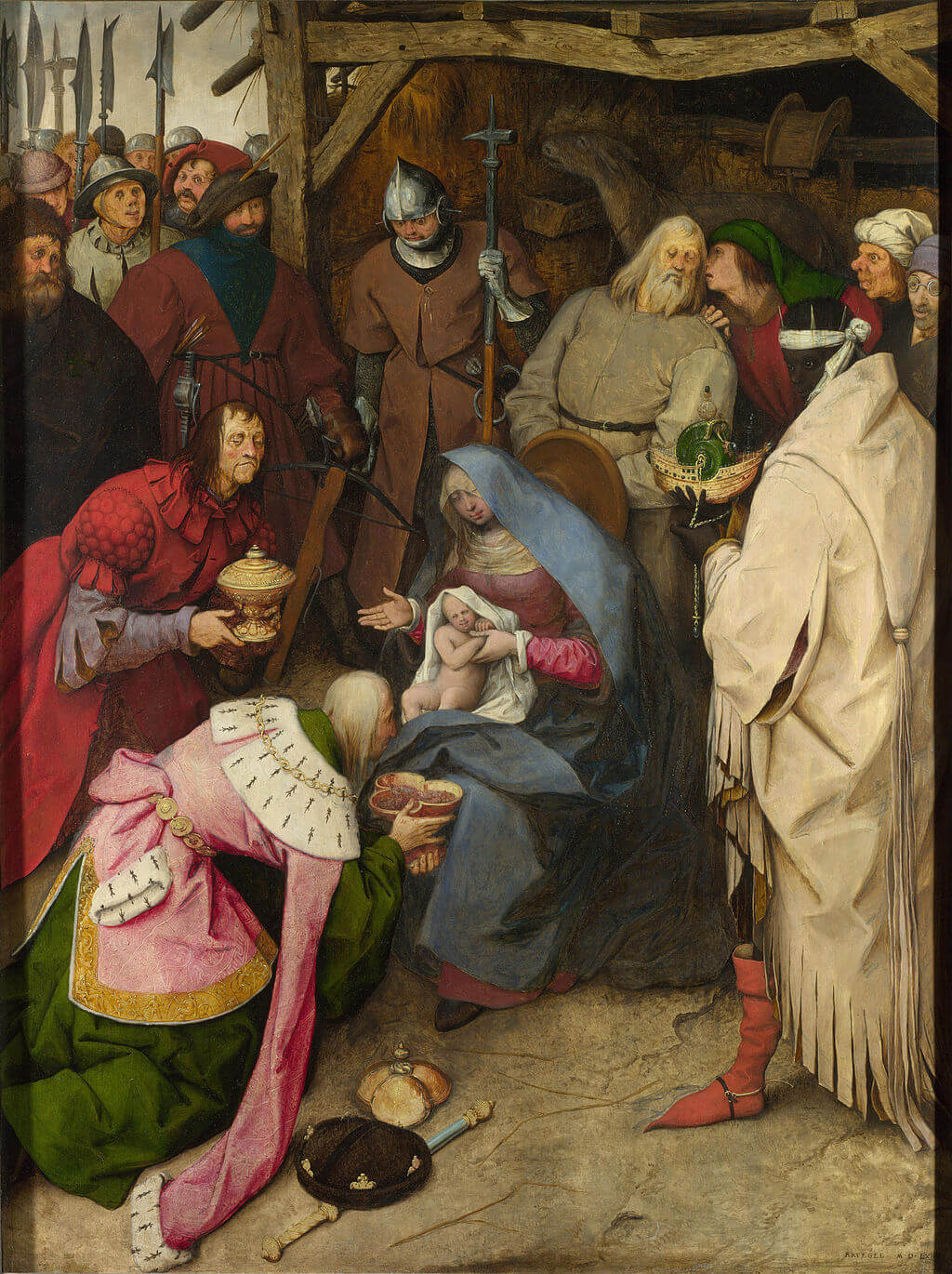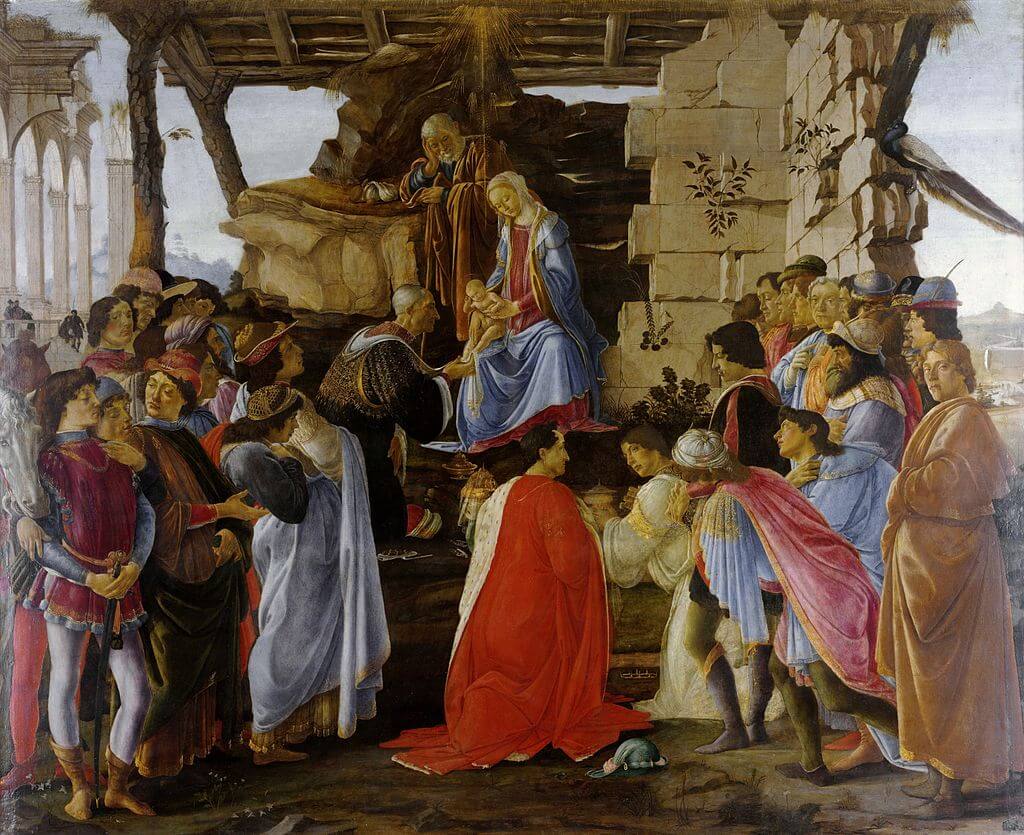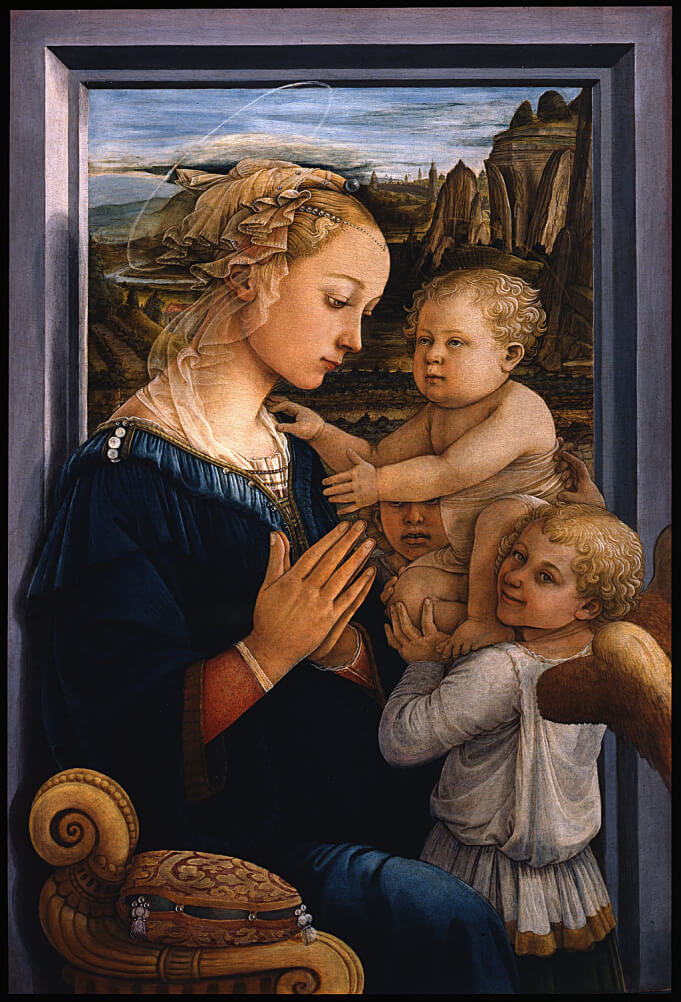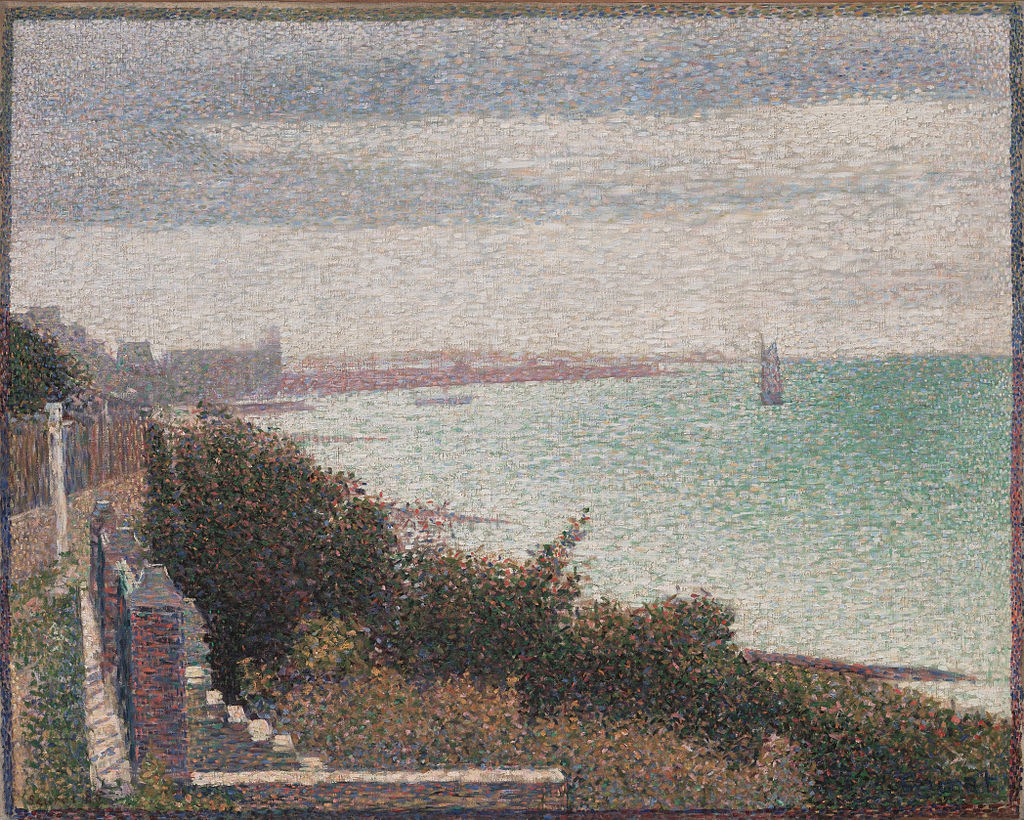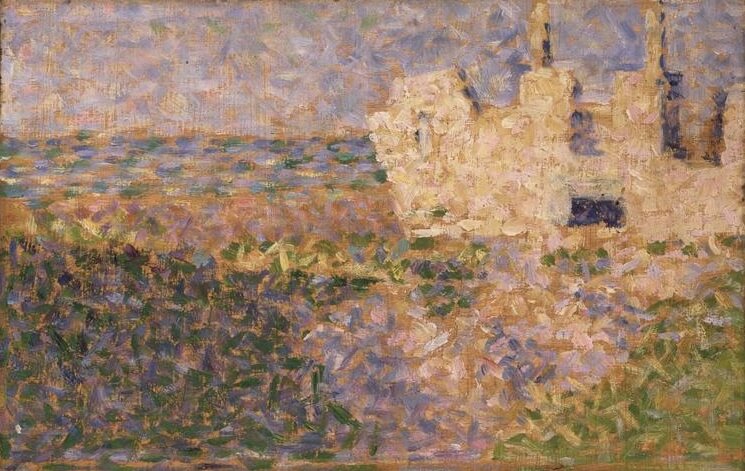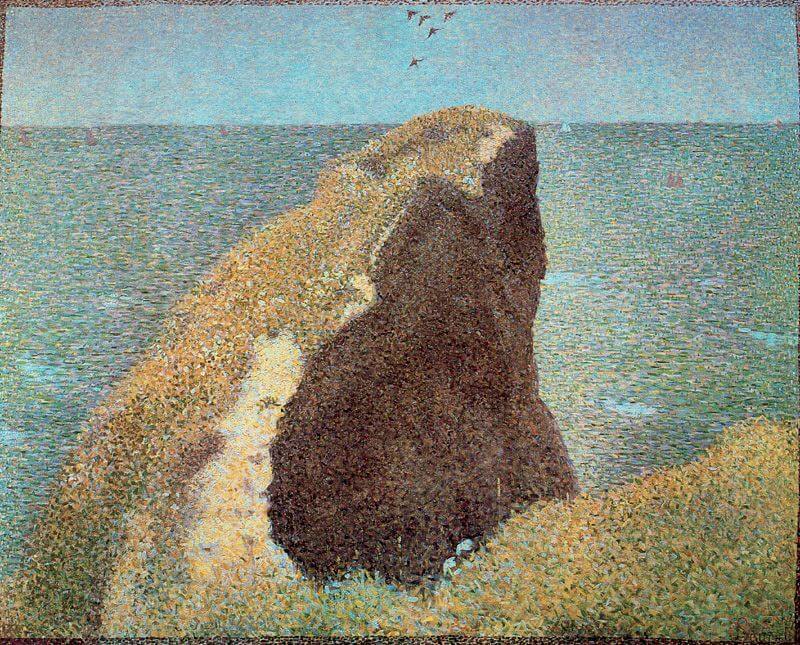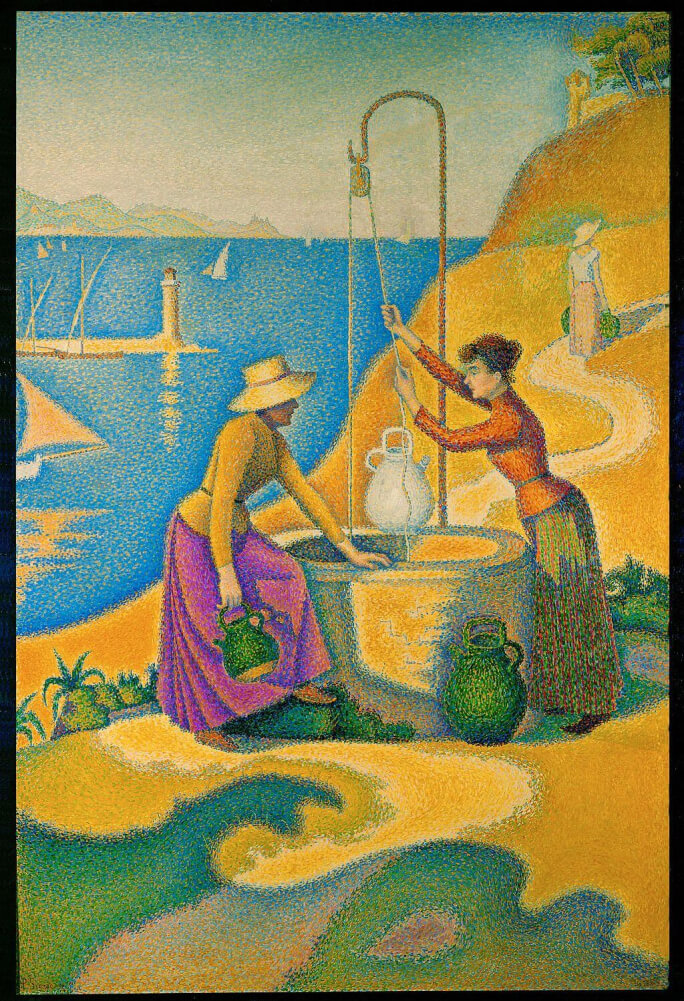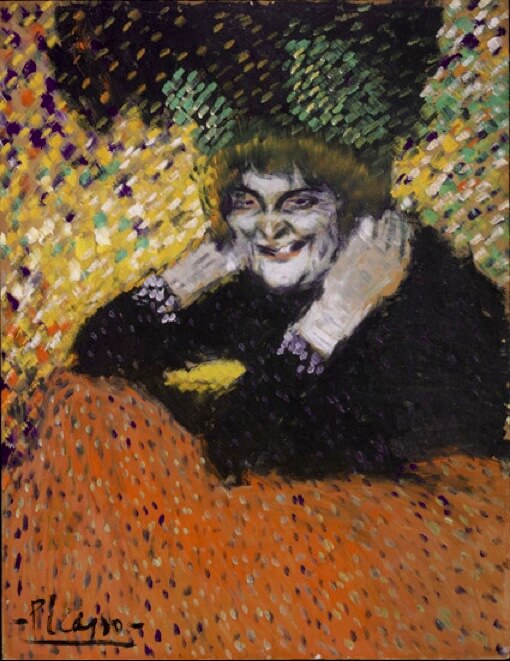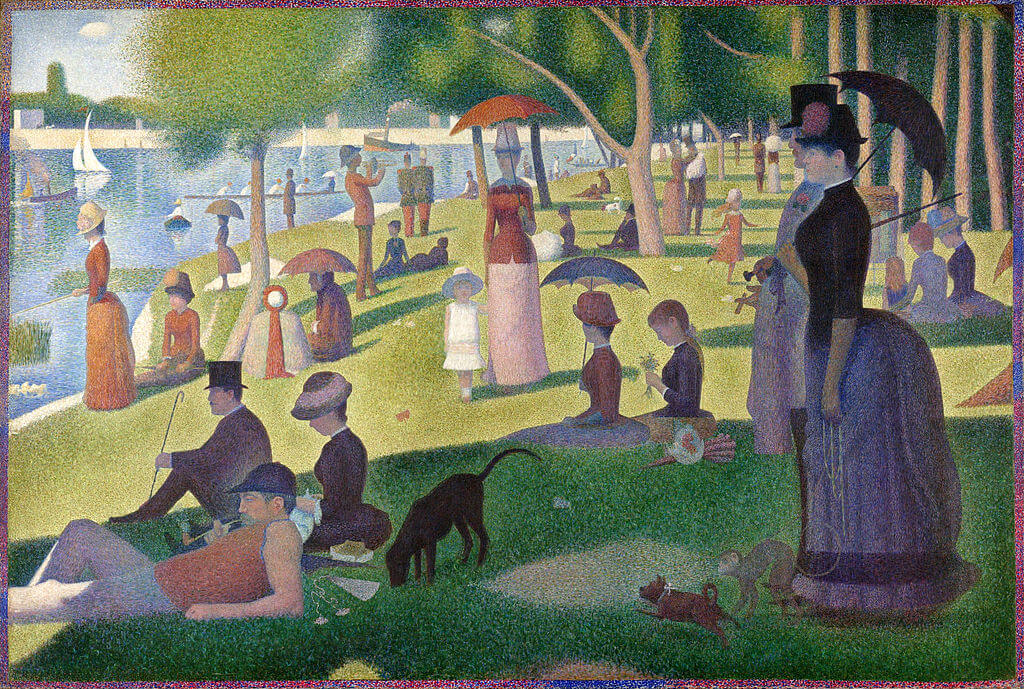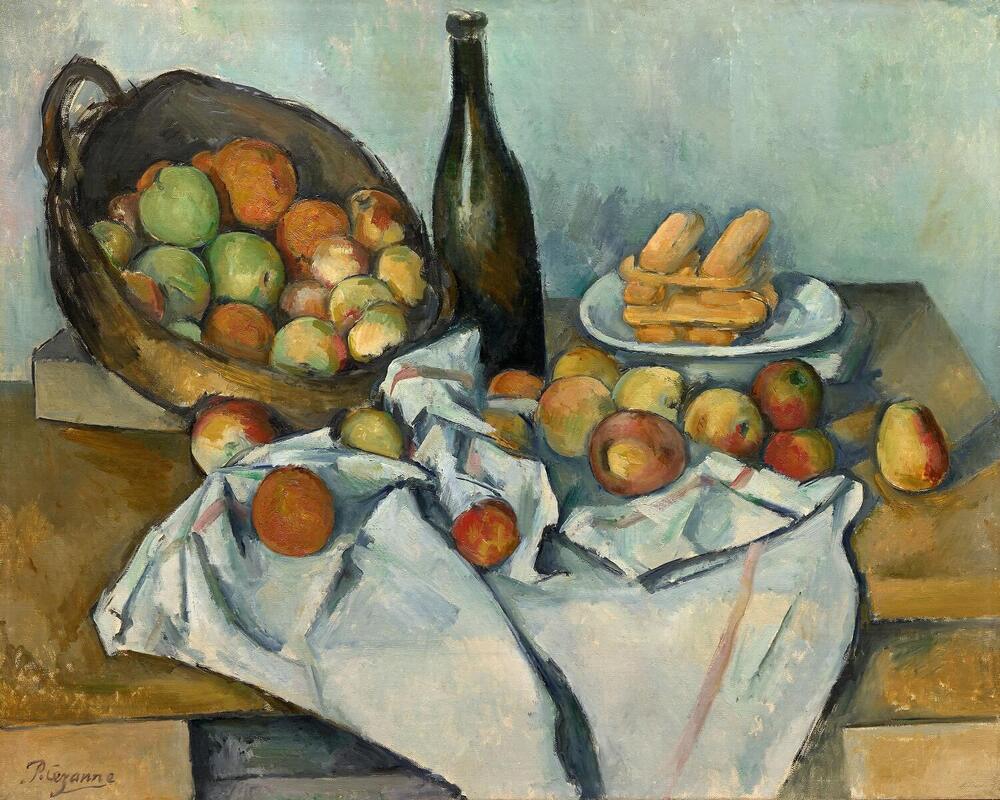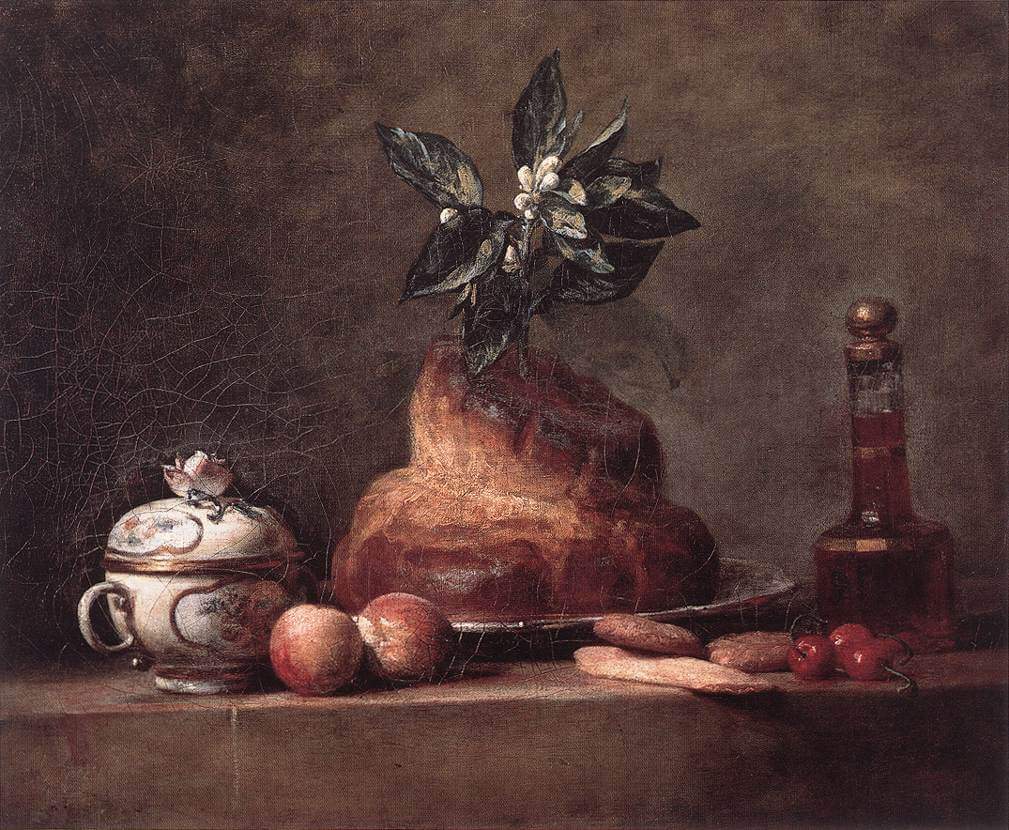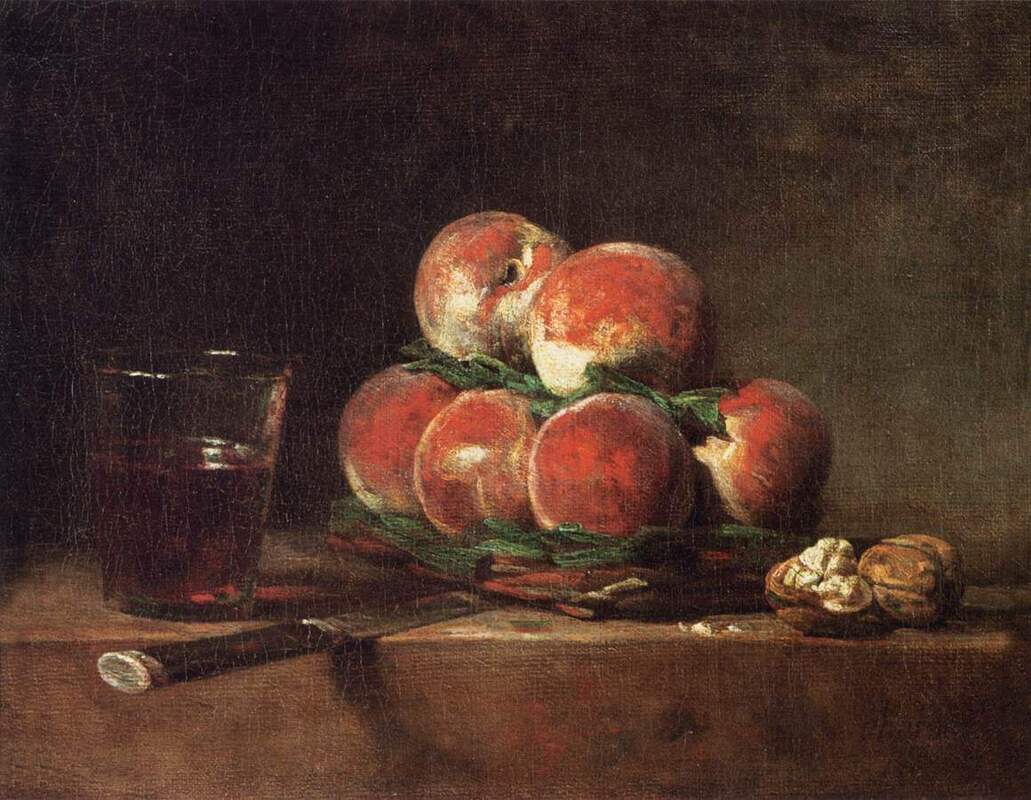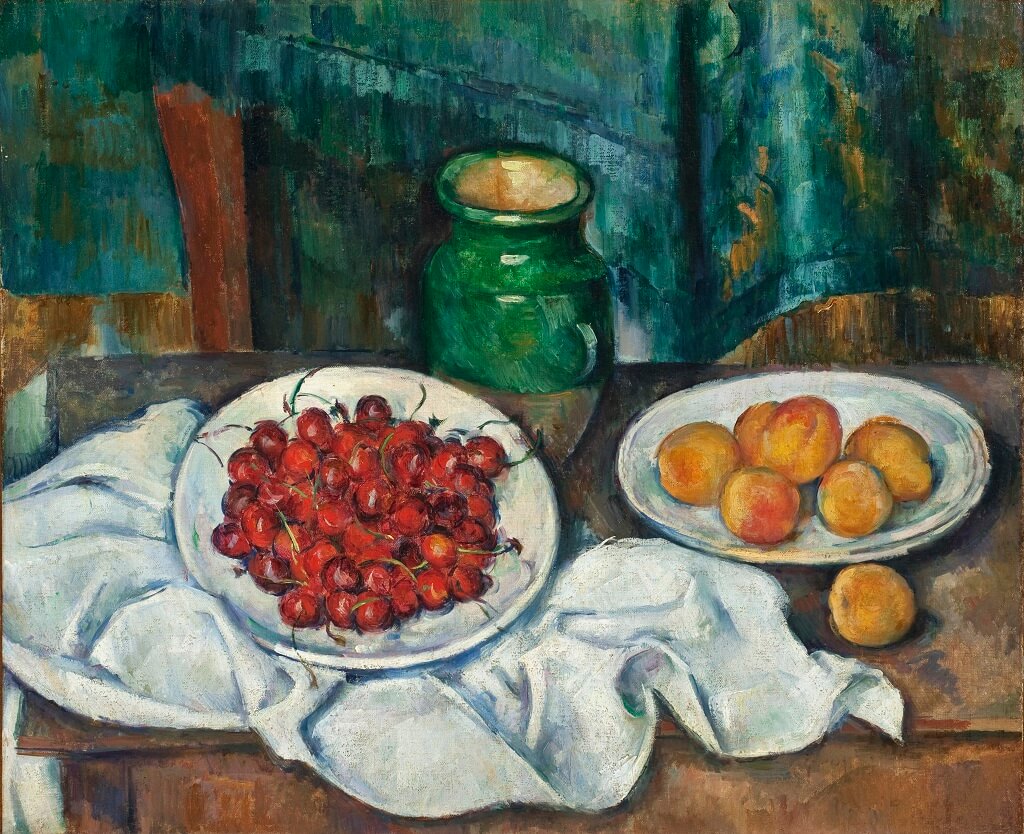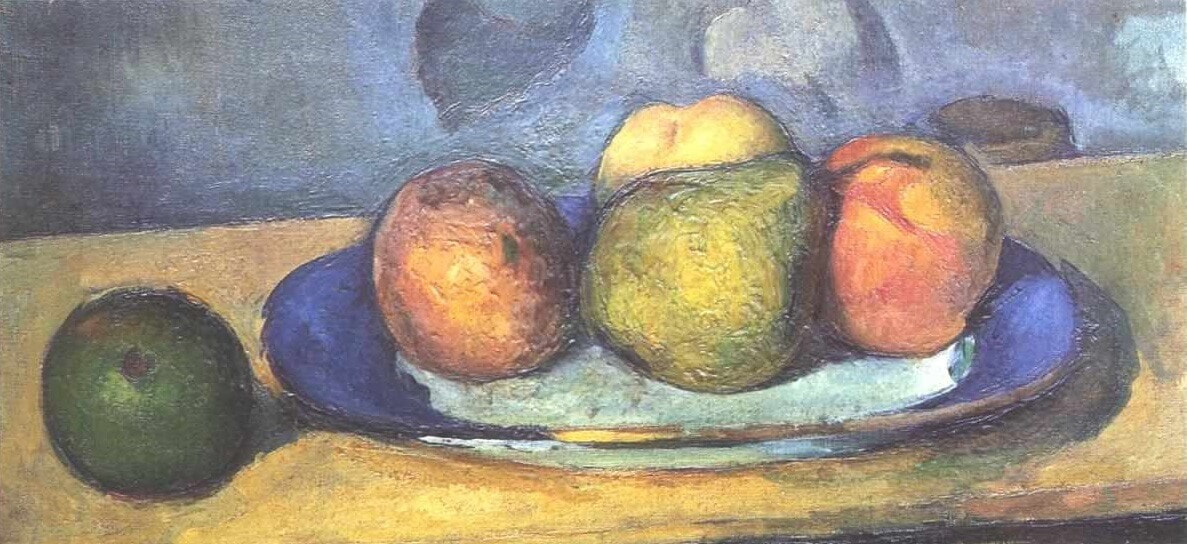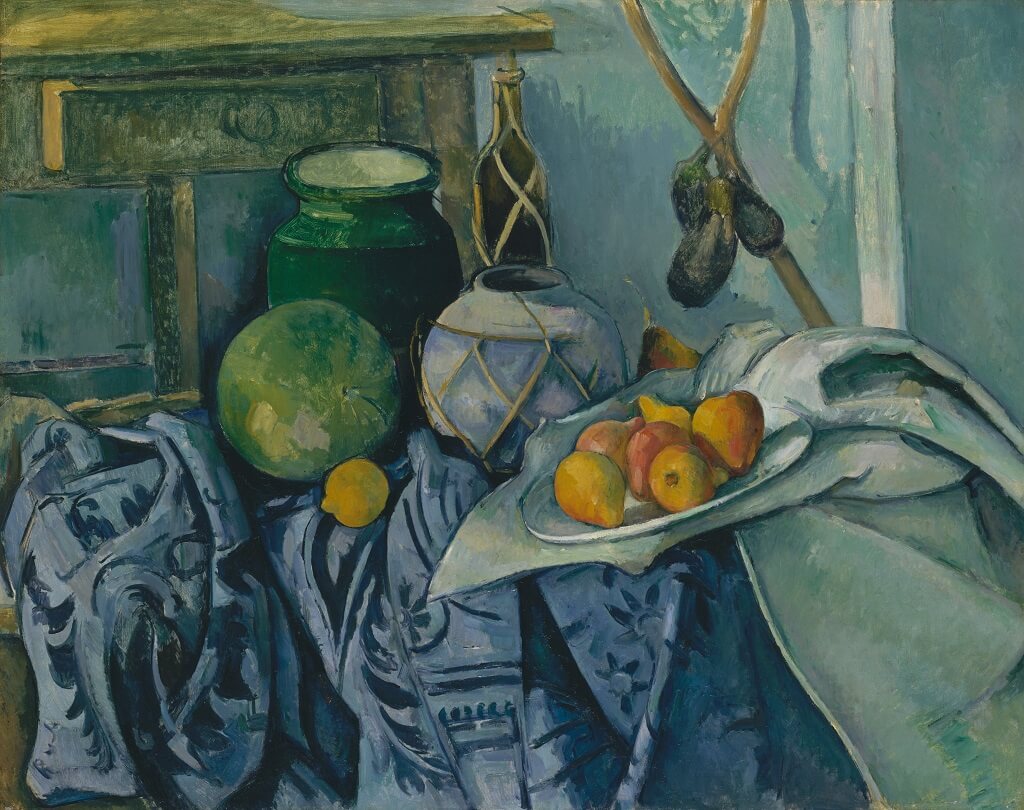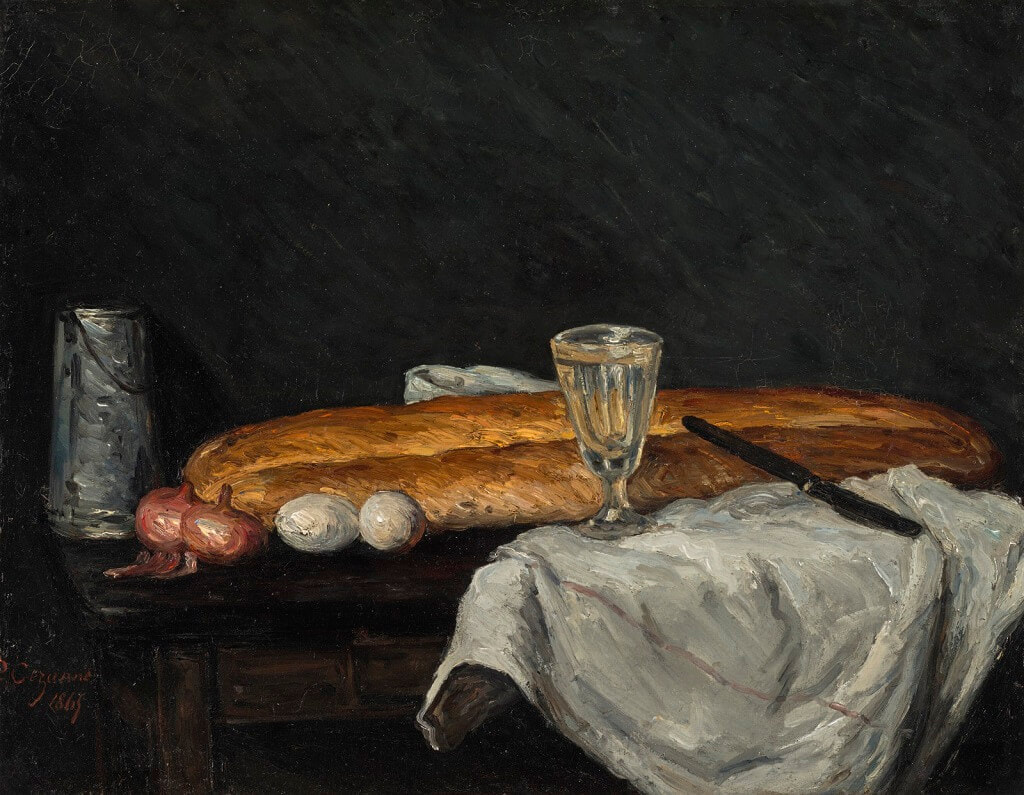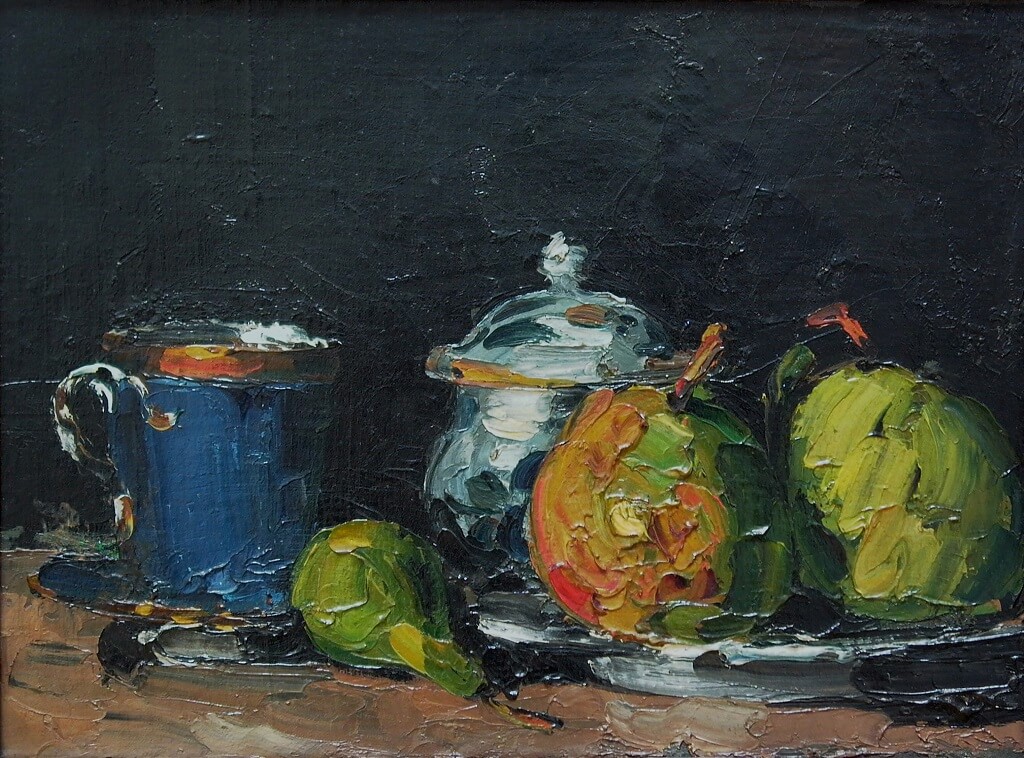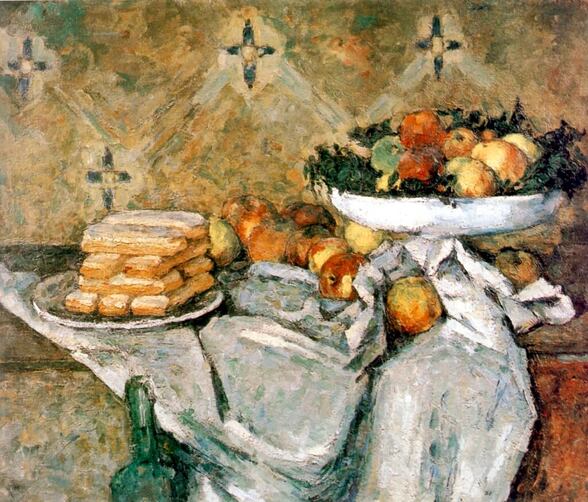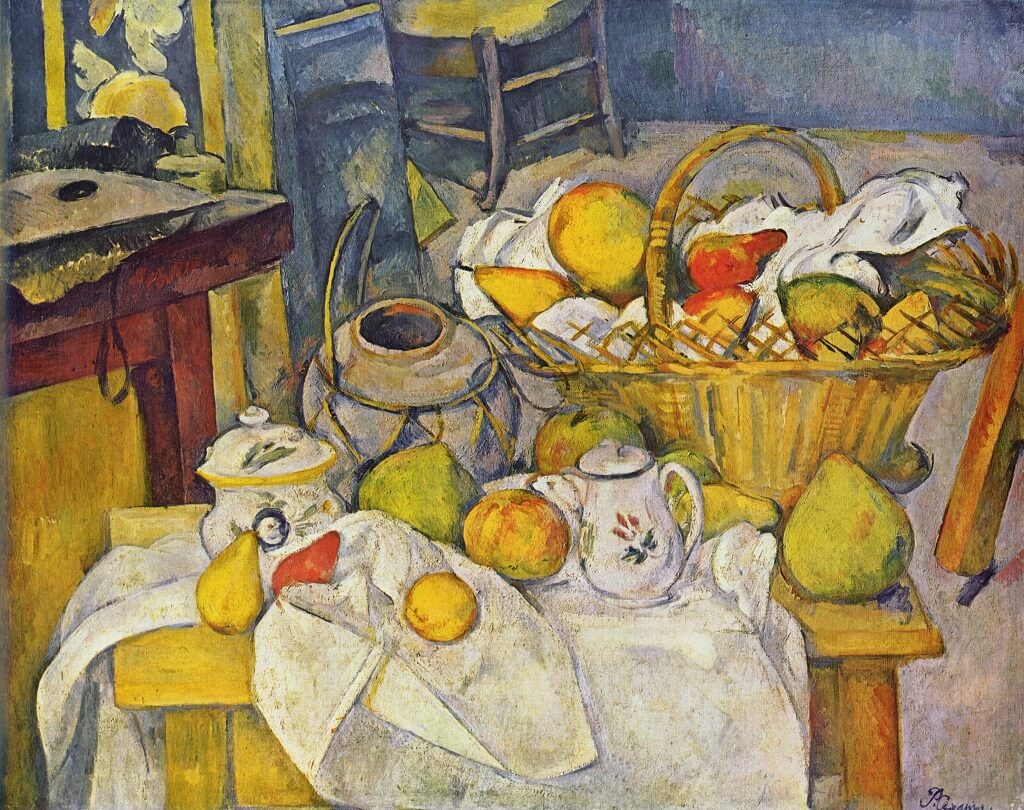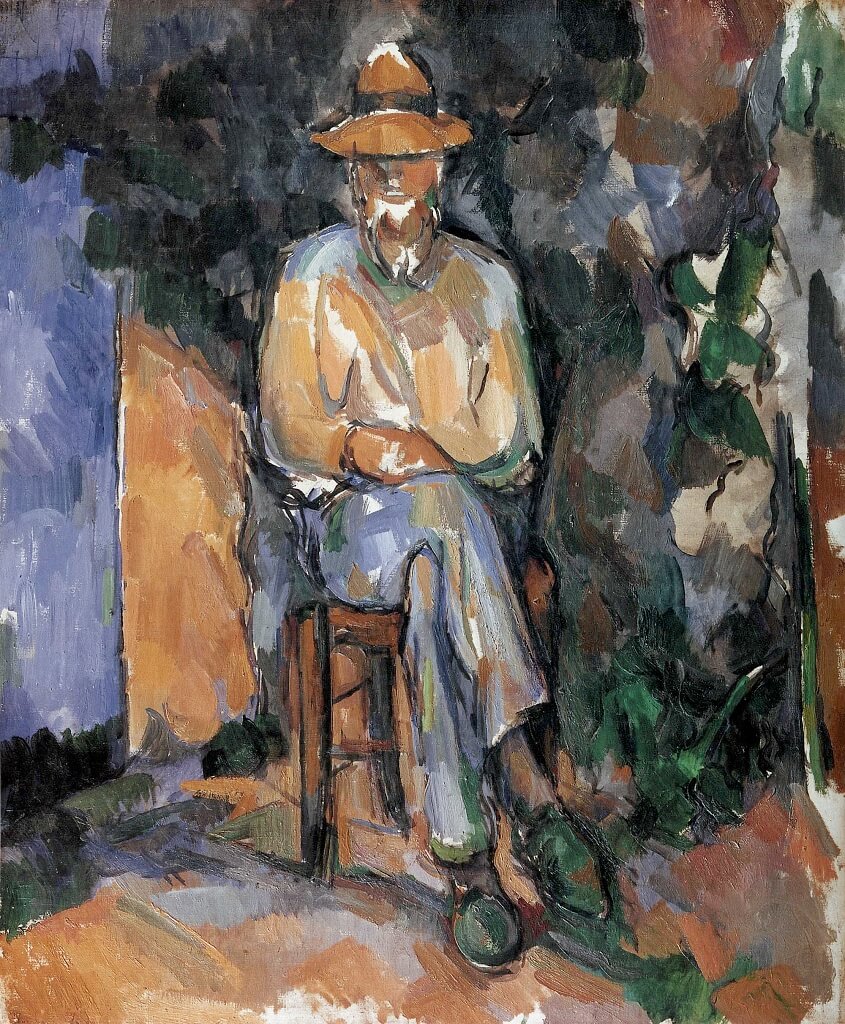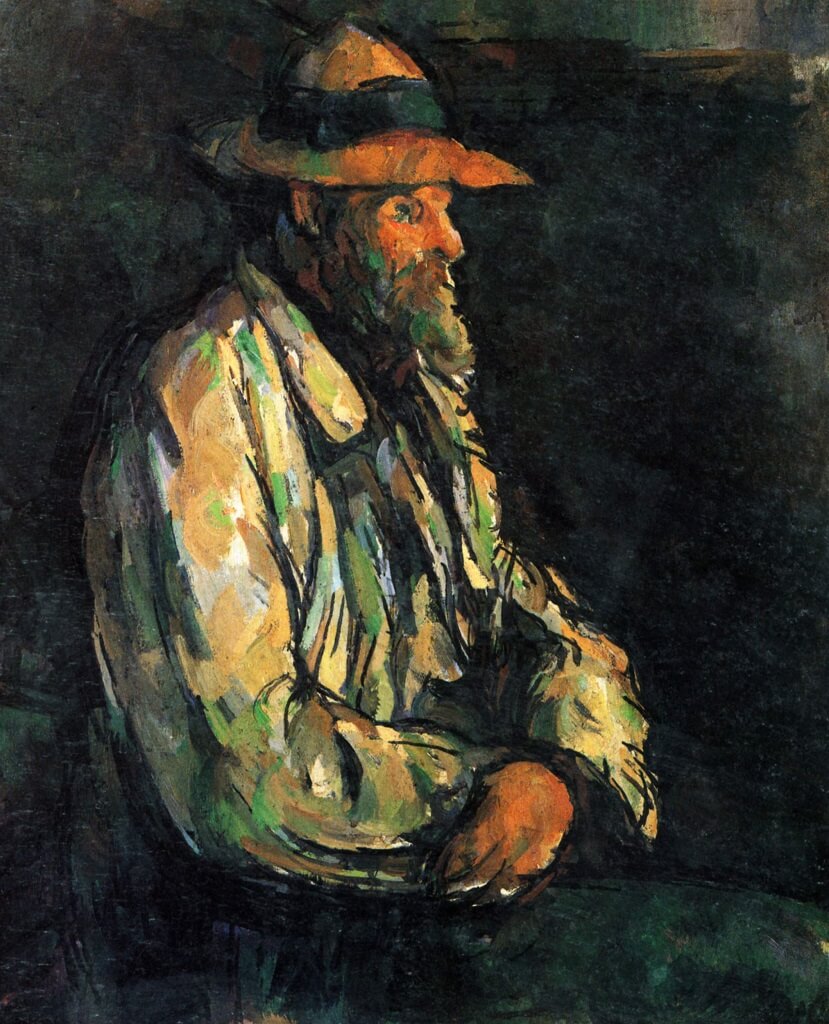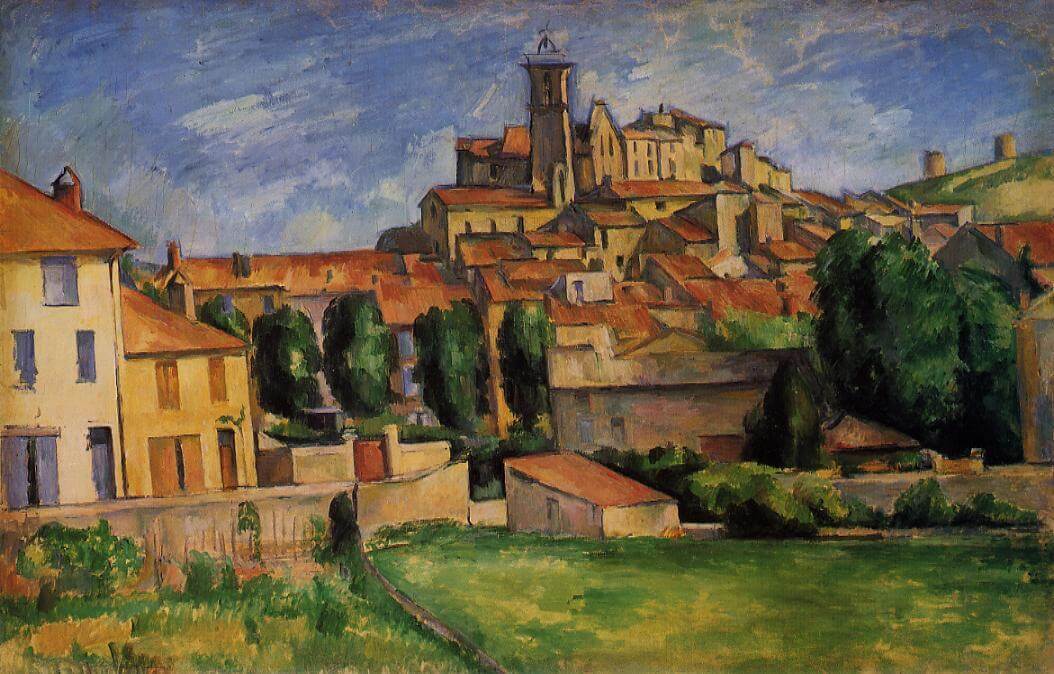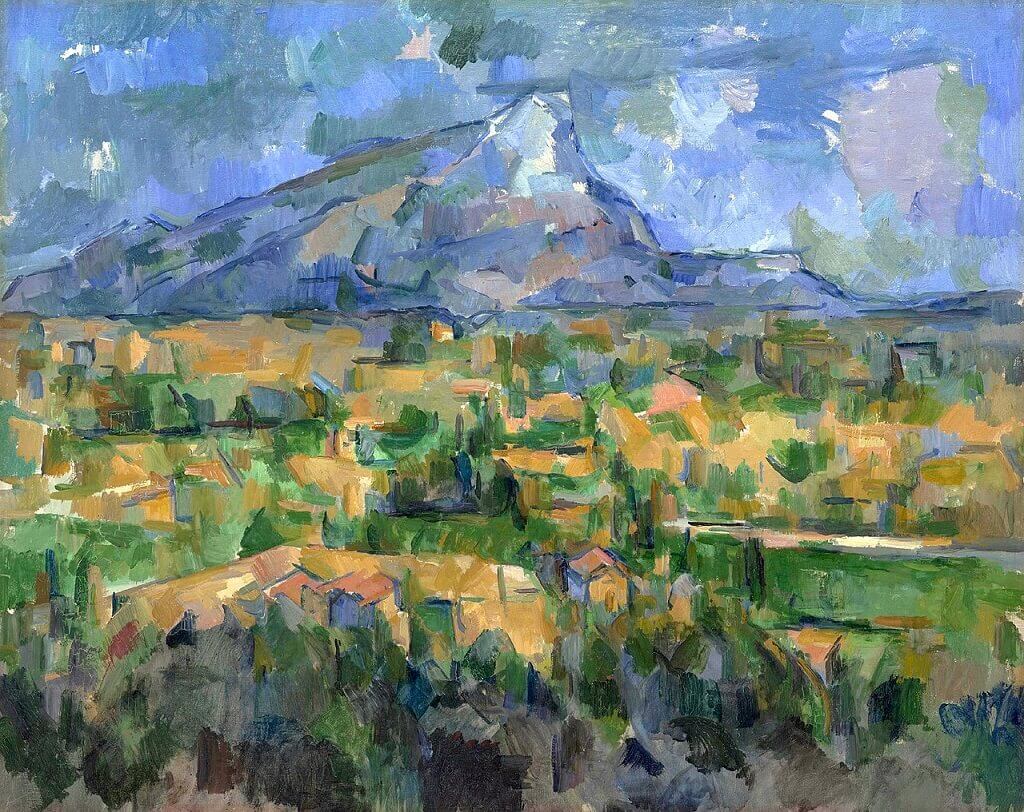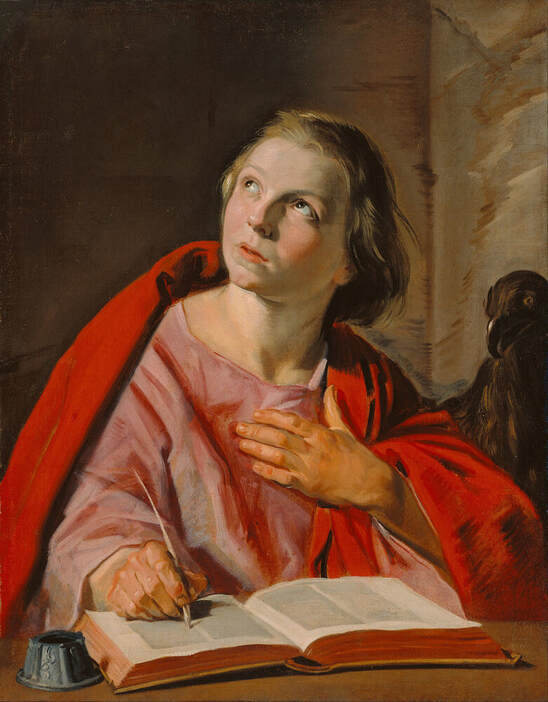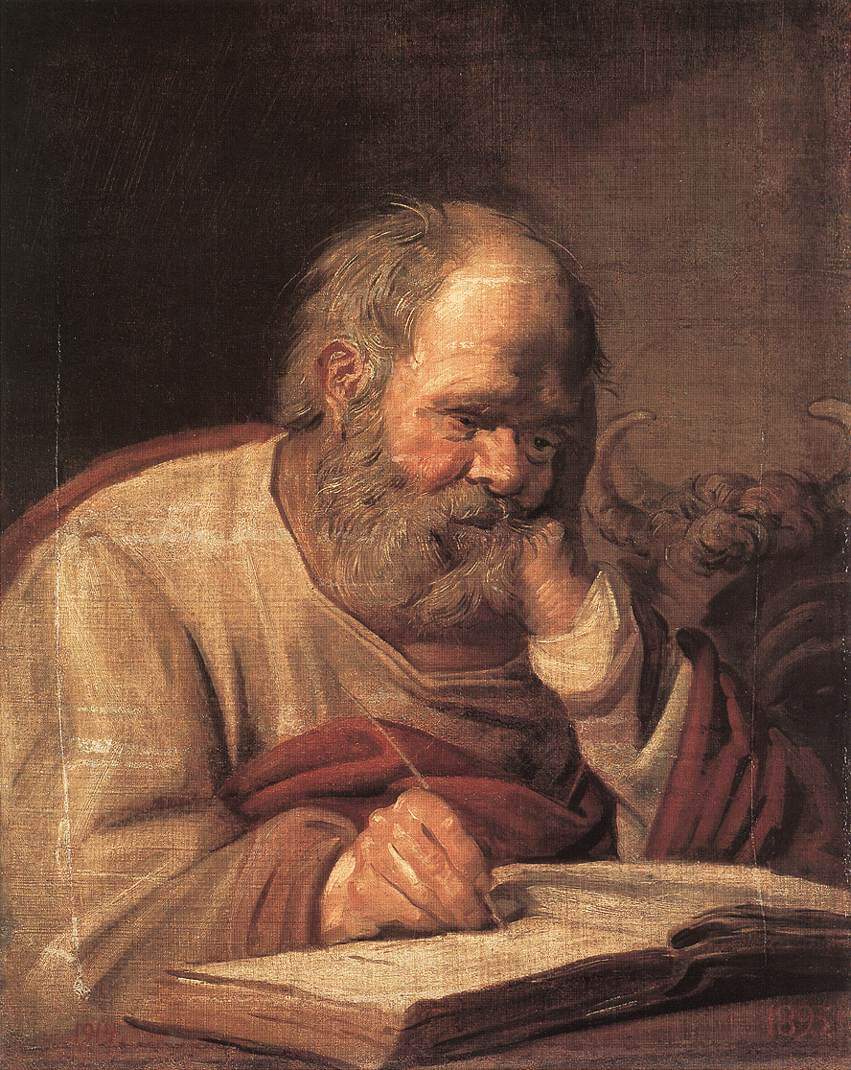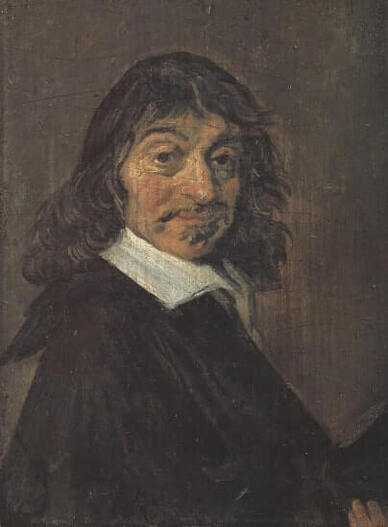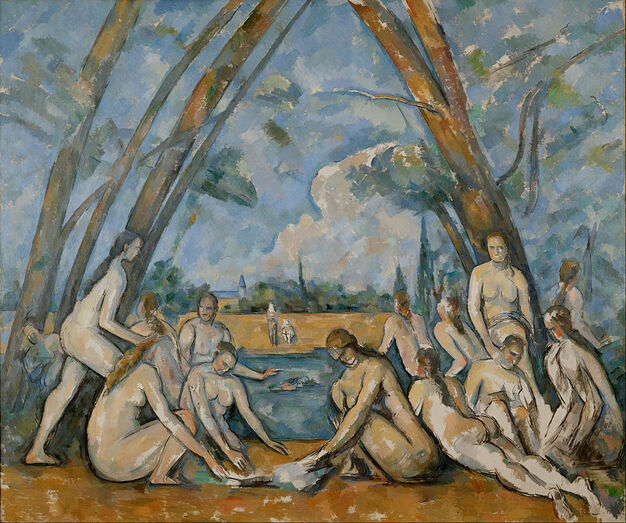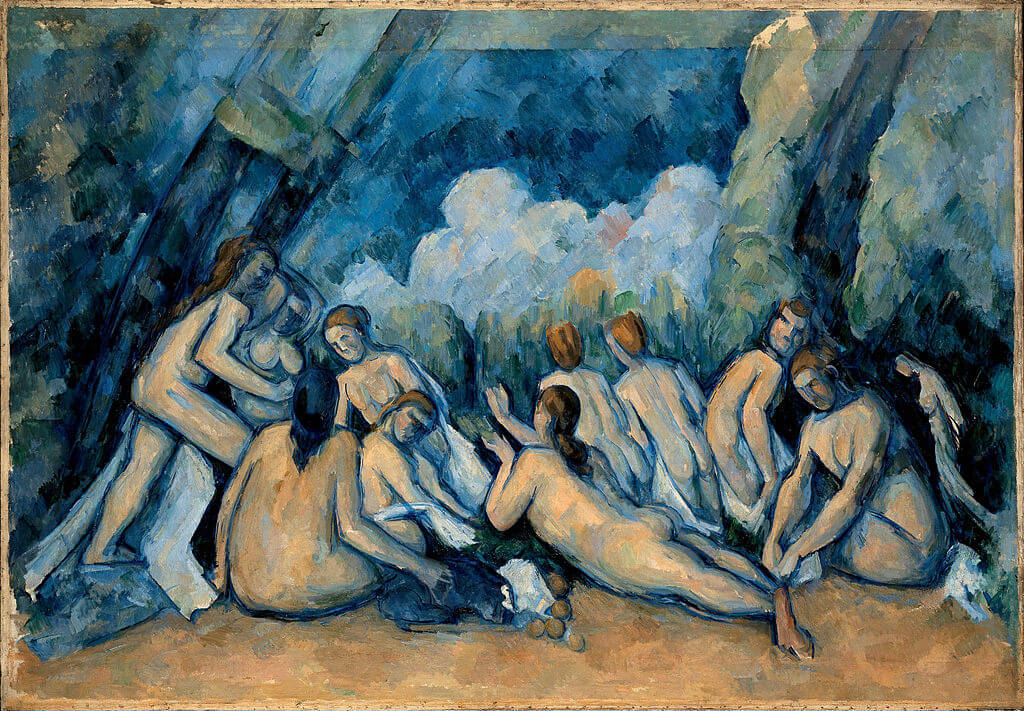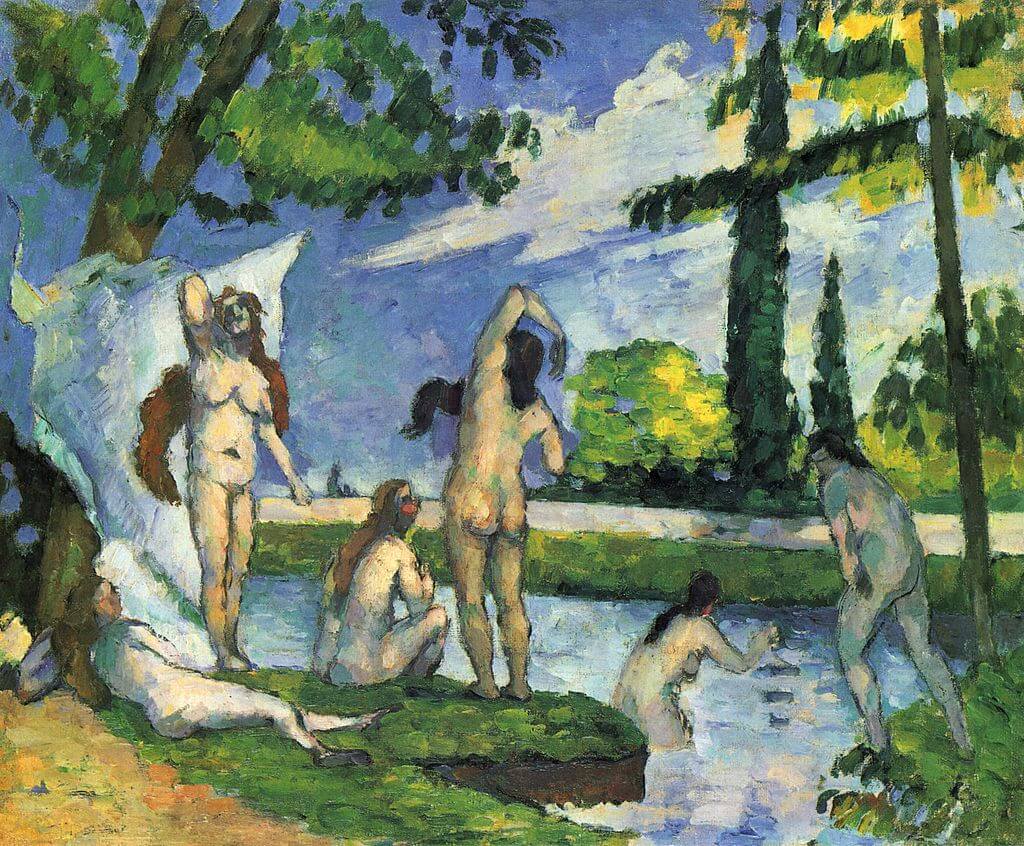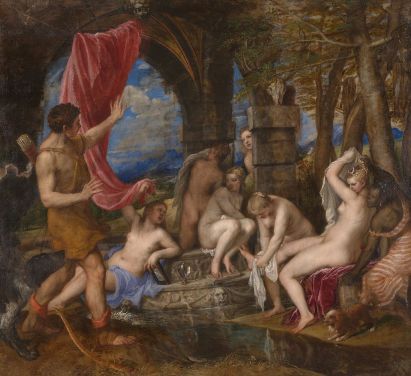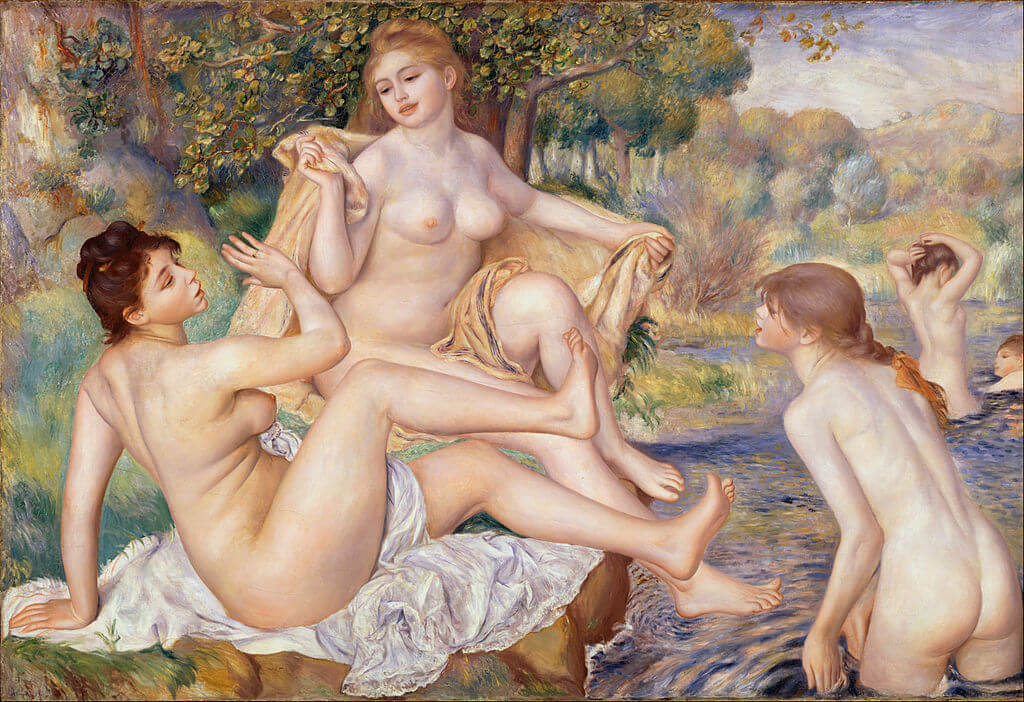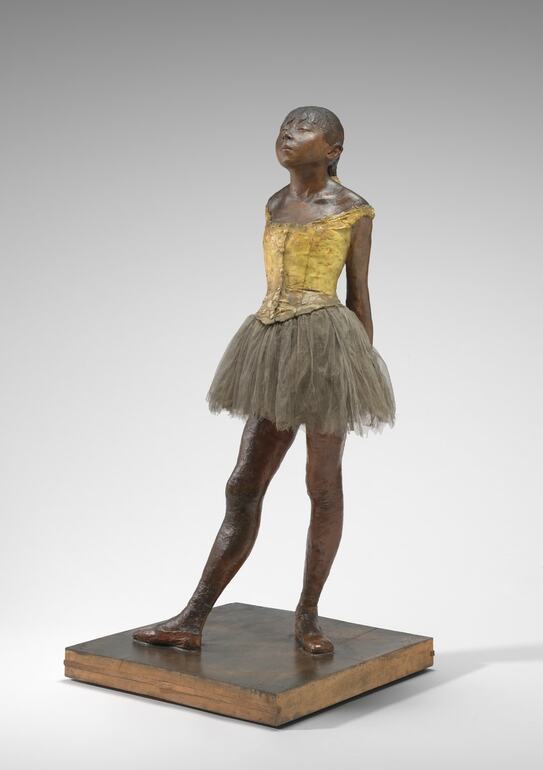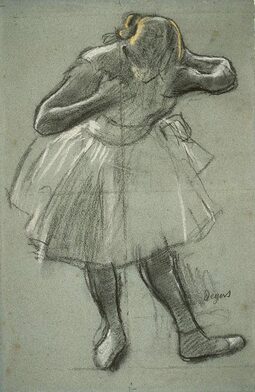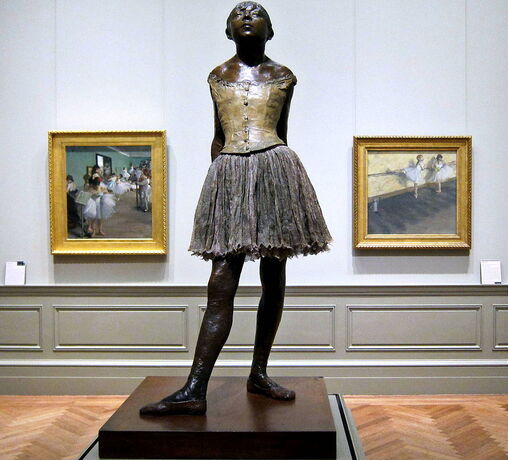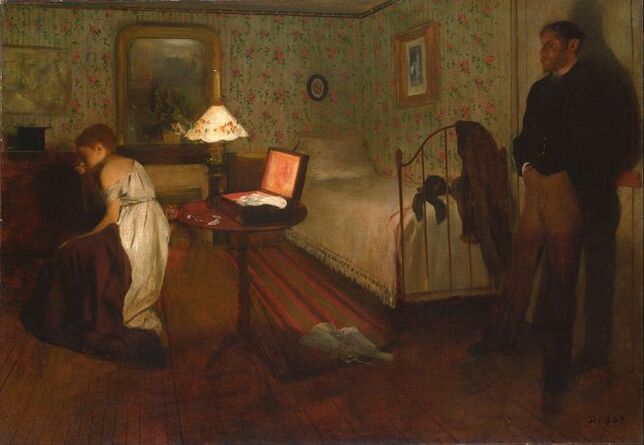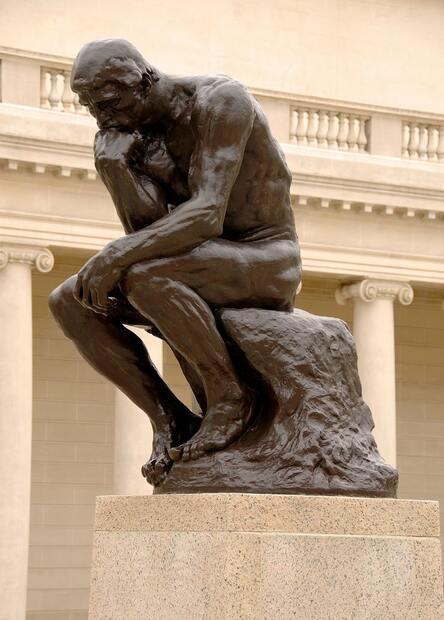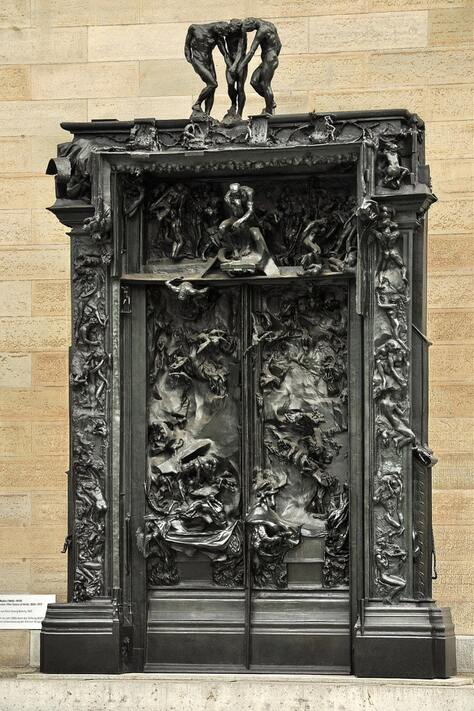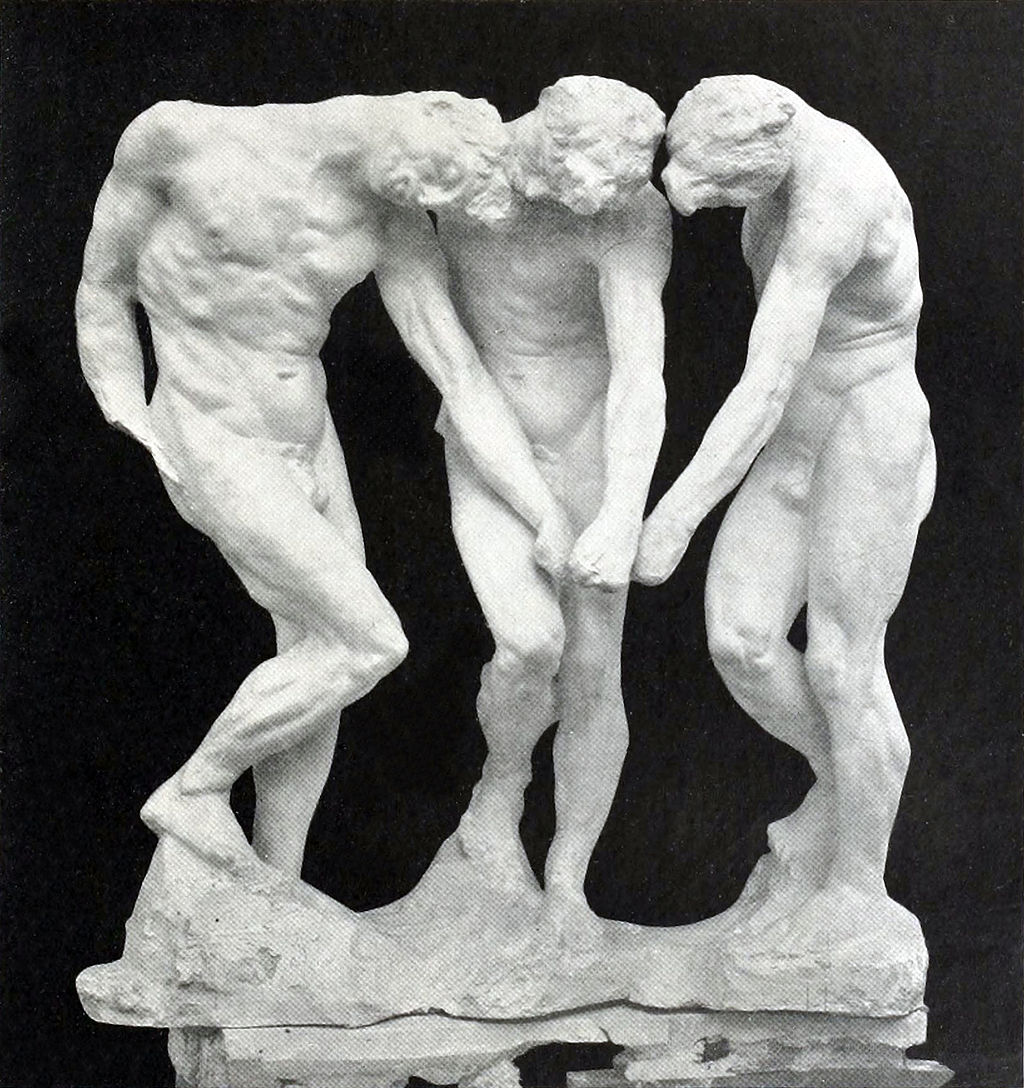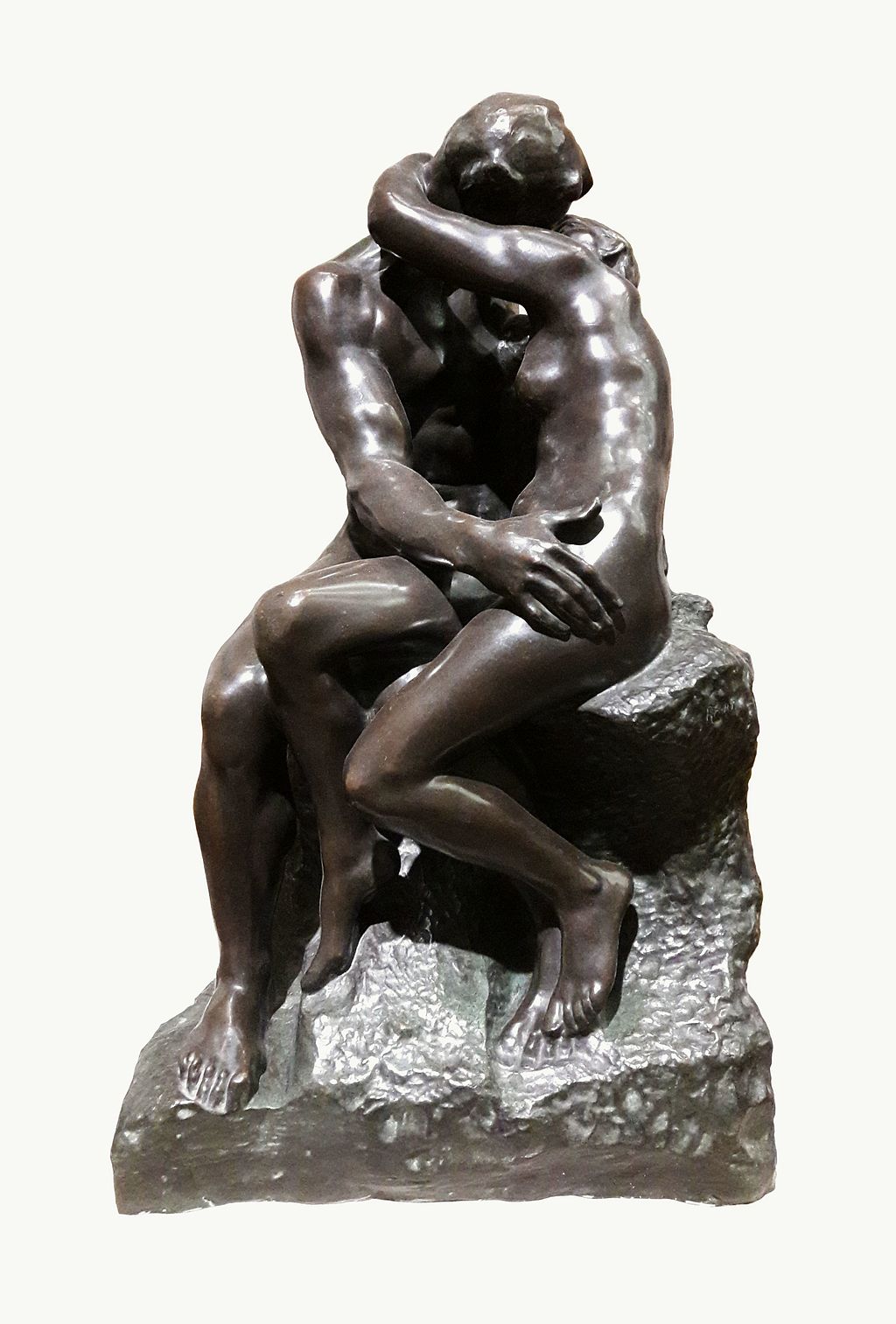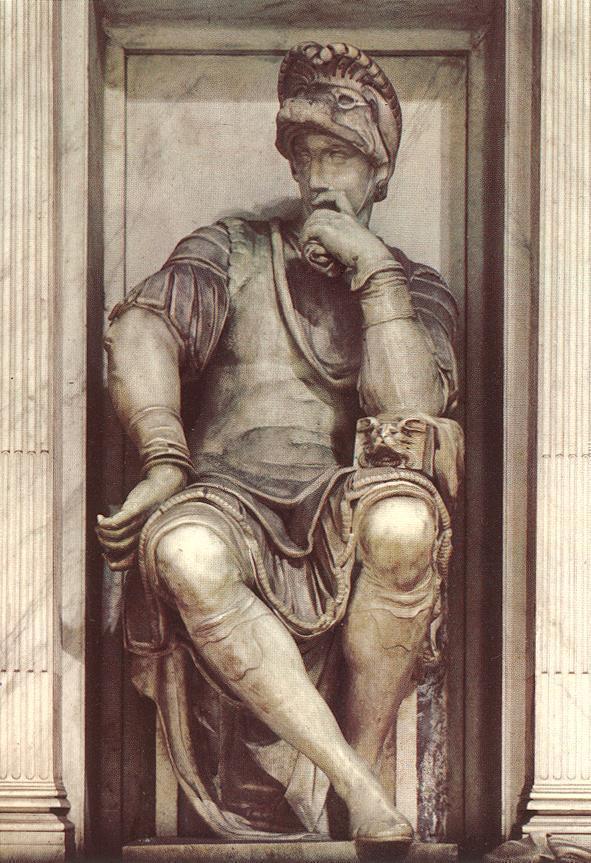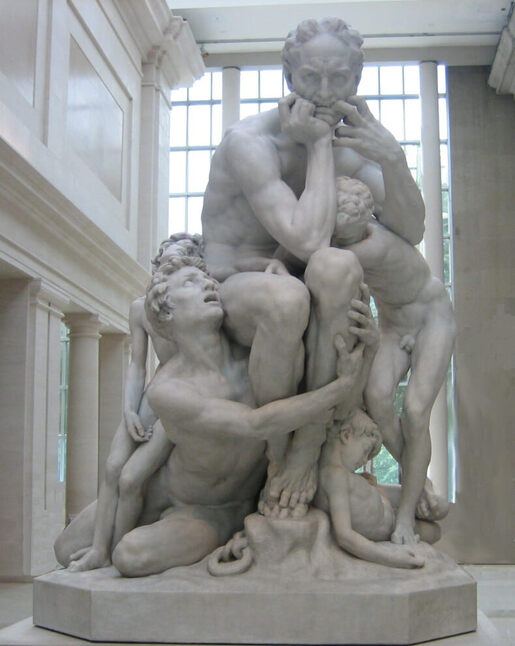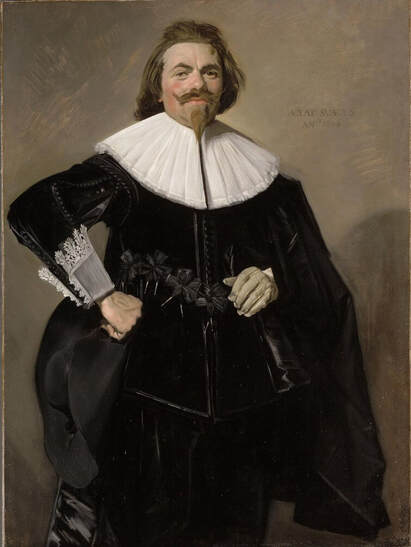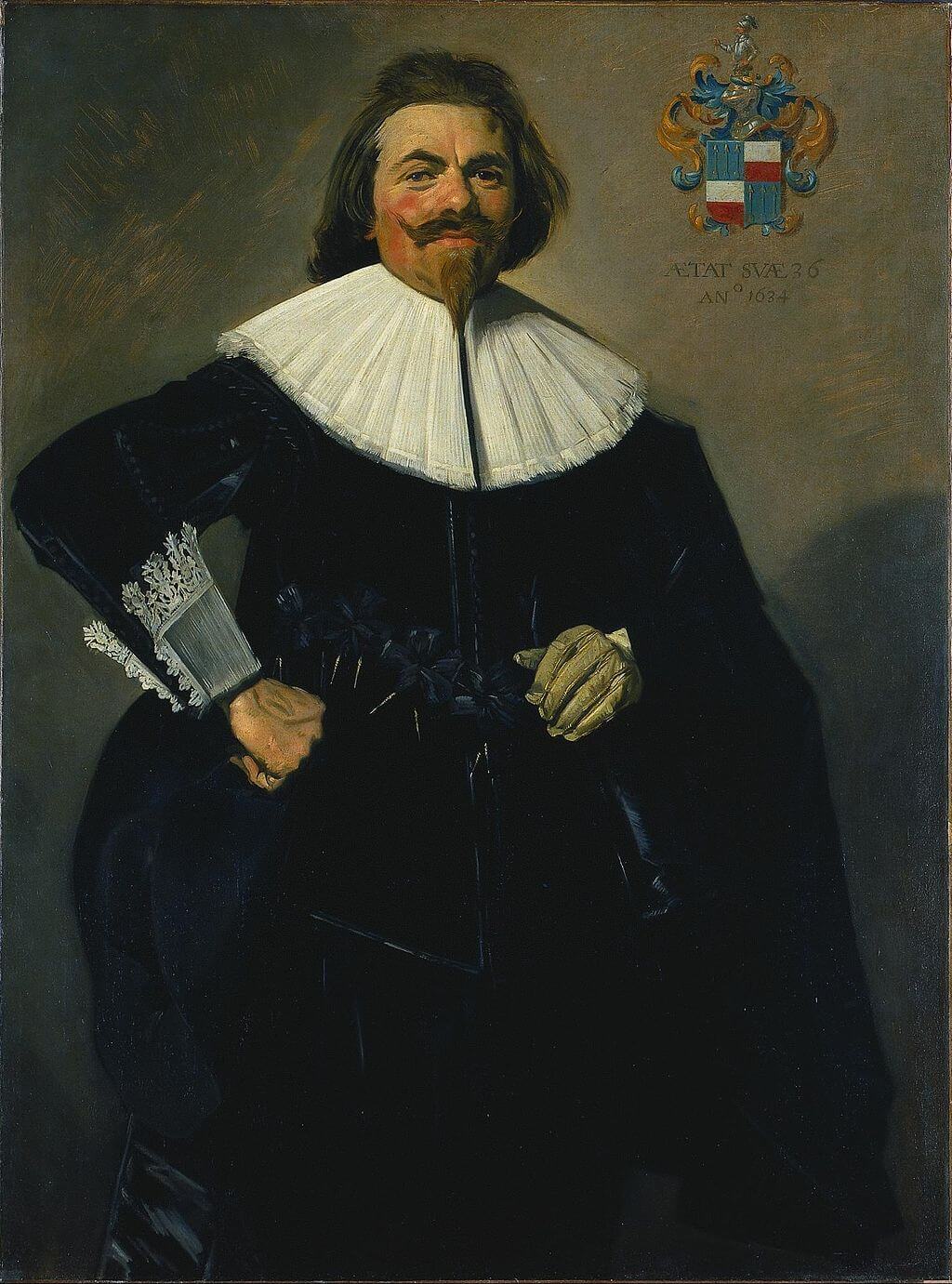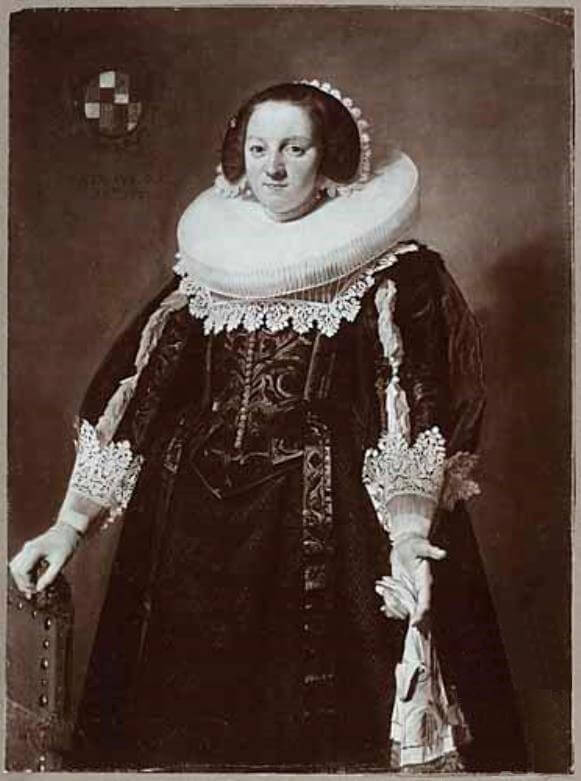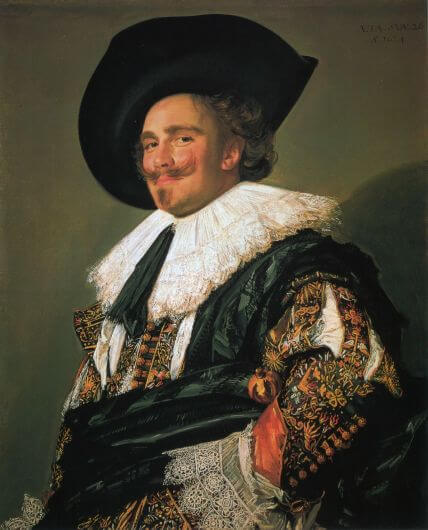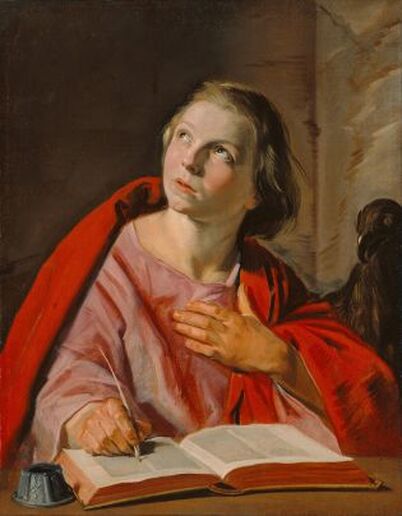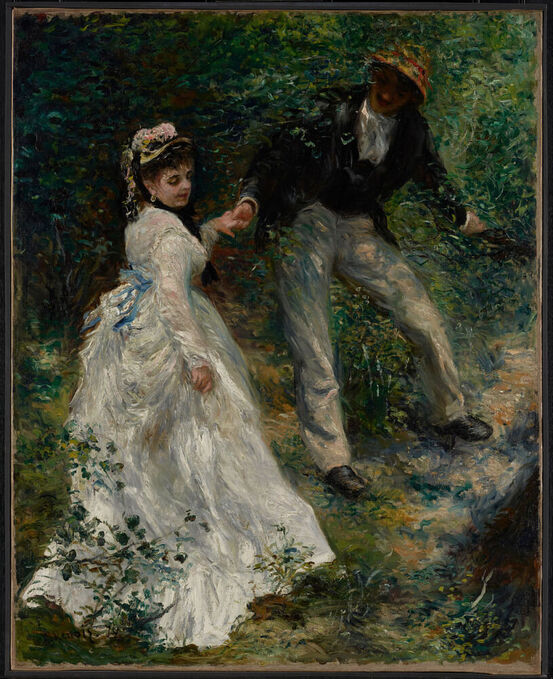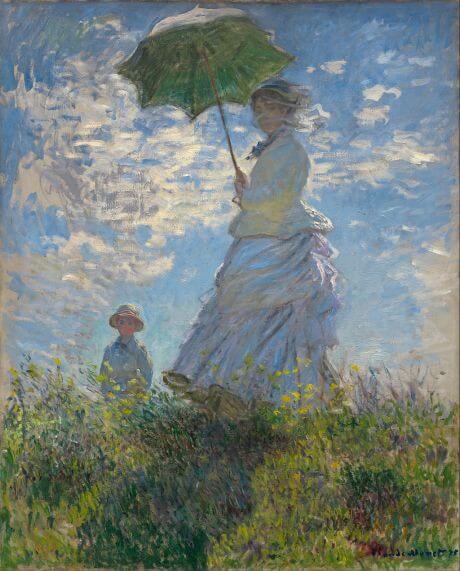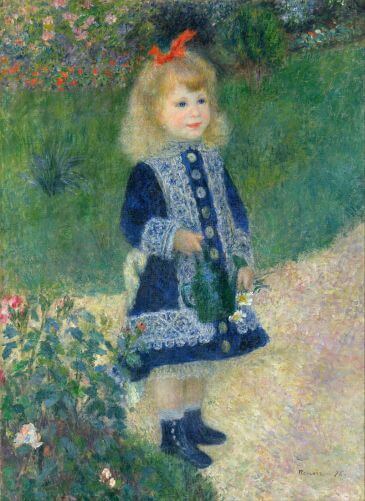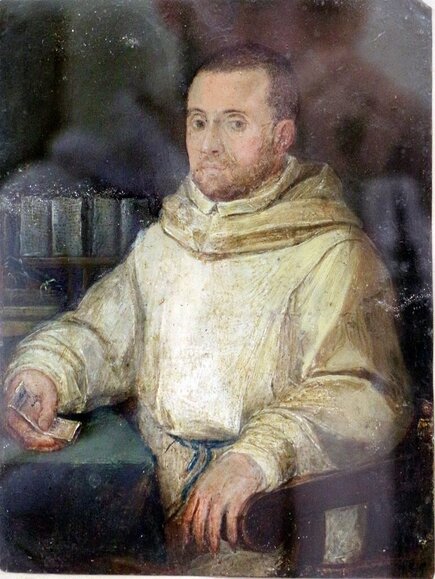|
Where? Gallery 4 of the National Gallery of Art
When? Between 1440 and 1460 Commissioned by? Most likely the Medici family What do you see? This tondo in a gold frame shows hundreds of people lining up to worship Baby Jesus. The line starts at the top right of the painting, goes around the back of the stable and the white building, and continues on the left side of the painting where people are entering under the arch. On the bottom right, the Holy Family is depicted. The Virgin Mary is wearing a blue dress and has Baby Jesus on her lap. You can see some pomegranate seeds next to the left hand of Jesus. To Mary’s right is Saint Joseph. To their left, you can see the typical donkey, ox, and manger. Behind and to the right of Mary and Joseph, you can see the three shepherds present at the birthplace of Jesus. In front of the line of people are the three Magi (also known as the three wise men or three kings) and behind them is their following. The first Magus is kneeling down in front of Jesus and touches his right foot. Jesus raises his right hand to bless him. The other two Magi are waiting behind him. The horses of the Magi are taken care of in the stable. Next to the stable is a group of blind and disabled people. Above them is a white architectural structure in decay and on top of this structure stands a group of five almost naked people. The painting contains various animals, such as cows, horses, camels, a donkey, an ox, a falcon, a peacock, a pheasant, and a dog. The two birds on the right of the stable probably represent a falcon (or a goshawk) attacking a pheasant. On the top right, next to the mountaintop, you can see even more faces cluttered together. Also, below the arch on the left, you can see sketches of more people and animals. Backstory: This painting is also known as the Washington Tondo or the Cook Tondo (named after a former owner of the painting). Fra Angelico started this painting, but before completing it, he was called to Rome by the Pope to complete several commissions in the Saint Peter and the Vatican Palace. Fra Filippo Lippi was then commissioned to finish the painting. In addition, it may be the case that several people in the workshops of both friars may have contributed to the painting. It is not entirely clear who painted which parts of the painting. The general idea is that Fra Angelico painted the figures with the thinner faces (like Mary) and Lippi painted the figures with the broader faces (like Saint Joseph and the Magus holding the foot of Jesus). It is thought that Filippo Lippi completed the majority of the painting. Symbolism: The painting contains various symbolic references:
Why the Adoration of the Magi? This theme was popular among Renaissance painters and has been painted by, among others, Botticelli, Pieter Bruegel the Elder, and Leonardo da Vinci. For example, Adoration of the Kings by Bruegel can be found in the National Gallery in London and Adoration of the Magi by Botticelli can be found in the Uffizi Museum in Florence. An important argument for the popularity of the adoration of the Magi theme is that artists could paint the luxury and colorfulness of the costumes of the Magi and their followers. This theme reflects the biblical story in Matthew 2 about the three kings who traveled a large distance following a big star to worship Baby Jesus. They brought three gifts for Jesus: gold, frankincense, and myrrh.
Who is Fra Angelico? Born as Guido di Petro around 1395, he was better known as Fra Angelico or Il Beato Angelico. He lived a very pious life and died in 1455. He started his career as a manuscript illustrator and moved on to become a painter of frescos and paintings.
He was beatified in 1982 by Pope John Paul II, because of his pious life and the amazing quality of his paintings. He was especially good in painting the most beautiful depictions of the Virgin Mary. One of his great works is the Coronation of the Virgin in the Uffizi Museum. Who is Filippo Lippi? Fra Filippo Lippi (1406-1469) was born in Florence. After his parents died and his aunt could not take care of him anymore, he was sent to a Carmelite convent. Unlike Fra Angelico, he lived a far-from-pious life, though he officially remained a friar throughout his life. He left the convent at age 26 and later in his life he even married and got a child, the well-known painter, Filippino Lippi. The Medici family recognized the talents of Filippo Lippi, and during his career, he completed at least nine paintings for them. One of his most famous works is the Madonna and Child with Two Angels in the Uffizi Museum.
Fun fact: An analysis by the National Gallery of Art has revealed that this painting was created over an extended period of time. It also seems that some of the animals in the painting were not initially included in the design, but only added later on, possibly by another painter than Fra Angelico and Filippo Lippi.
Analysis revealed, specifically, that the peacock, falcon, pheasant, and hunting dog were added on top of areas that were already painted. This was probably under the influence of the Medici brothers Piero and Giovanni. Note that the birds are painted bigger than they should realistically be, compared to the rest of the painting, to emphasize their symbolism. They distract the viewer from the real theme of the painting. Interested in a copy for yourself? Poster or canvas.
2 Comments
Where? Floor 5, Gallery 1 of the Museum of Modern Art When? 1885 What do you see? The arrival of the evening in Grandcamp on the Northwest coast of France. The sky is a beautiful combination of white, silver, and gray. On the right is the Atlantic Ocean with a single sailboat. Seurat painted the sea and the sky using small horizontal brush strokes to indicate the direction in which the sea and sky are moving. In contrast, he painted the using dots of paint, which you can see very clearly when standing close to the painting. Some of the objects are very unclear from up-close. For example, look at the sailboat on the sea. However, from a distance, all the dots and small brush strokes come together, and the different elements of the painting become very clear. From a distance, we have no problem identifying a sailboat in this painting. Backstory: In 1885, Seurat spent his Summer in Grandcamp, Normandy, on the French coast. That Summer he painted several seascapes. Two examples of other works he created in Grandcamp that Summer are Ruins at Grandcamp in the Musée d’Orsay and Le Bec du Hoc, Grandcamp in Tate Modern.
Beyond Impressionism: Impressionism developed under the lead of Édouard Manet in the 1860s, and by the 1880s, Impressionism gained quite some popularity. However, among the next generation of artists, there were several innovative painters that went beyond Impressionism, usually labeled under the umbrella term Post-Impressionism.
What is Neo-Impressionism? An art movement created by Georges Seurat in 1884. Neo-Impressionism involved a scientific interpretation of colors and lines. The paint was applied in pure, unmixed dots and blocks of colors, creating a strong sense of organization. Scientific principles guided the choice of contrasting colors such that the colors interacted optically (instead of mixing the colors in the painting). This creates a special effect for the viewer. Looking at the paintings from nearby, one sees a lot of dots of pure colors. However, from a distance, these colors interact beautifully, and the painting becomes a unified whole of almost unmatched clarity. One great example of this style from 1892 is Femmes au Puits by Paul Signac in the Musée d’Orsay. A later example from 1902 is Old Woman by Pablo Picasso in the Philadelphia Museum of Art.
Who is Seurat? Georges-Pierre Seurat (1859-1891) was born and raised in Paris. He only became 31 years old and died in the midst of his career from an unknown disease. He was a Post-Impressionist painter. He can be classified even more accurately as a Neo-Impressionist painter.
Seurat received a classical art training at the traditional École des Beaux-Arts in Paris. While his painting style was far from traditional, his ideas benefited greatly from his education. He used a scientific approach to painting, whereby different colors can create different emotions and combining specific colors can create harmony in a painting. Seurat decided not to combine colors in a painting, but instead to apply the colors separately, using small dots, and let the viewer combine the colors in his/her mind. The best-known painting by Seurat is A Sunday at La Grande Jatte – 1884 in the Art Institute of Chicago.
Fun fact: Seurat completed this painting in 1885. Only three years later, he added the border of the painting. He did this to increase the brightness of the colors. This addition perfectly fits with the ideas and style of painting that Seurat used. The colors are carefully chosen to complement each other, and the contrasting colors in the border make the painting itself, and especially the sea and the sky stand out more.
Interested in a copy for yourself? Poster
Where: Gallery 248 at the Art Institute of Chicago
When: c. 1893 Medium and Size: Oil on canvas, 65 cm x 80 cm (25.6 x 31.5 in.). What do you see? At first glance, the tabletop, the basket of apples, wine bottle, plate of biscuits, apples tumbling across the tablecloth and surfaces, may appear to be a straightforward still-life painting but a longer look will show that it is much more than that. Cézanne had been rejected by the public for so many years that he had freed himself to see and paint to his own dictates. His still-life depictions are complex compositions that continue to provide the harmony and unity of his subjects that was so important to his philosophy of art, but he was experimenting at the same time. At first glance, we see a pleasing colorful painting that invites us in for a longer look. Cézanne, while showing himself and his viewers a kaleidoscope of perspectives, broke the rules of art with impunity. This painting provides a perfect example of what he did in order to portray our human visual perceptions that operate on so many levels in order to interpret our surrounding environment and what we see. Impossible Perspective? The longer look reveals a table that is impossible. The supports on the left and right sides are not the same height. The tabletop is not even on both sides and also not the same color. An extra tabletop can be seen on the right side. The back of the table on the left and right sides are also not on the same levels. We are looking at a variety of differing viewpoints. The table is tilted towards the viewer and on the left, yet another level supports the apple basket in a position that seems impossible as well. Does the wall support the basket? The green wine bottle is not symmetrical and leans slightly towards the left. Does it also support the basket? Even the biscuits on the plate provide differing views; we see both a side and top view at the same time. Cézanne has manipulated the biscuits by angling and elevating the two upper biscuits so we see two whole tops. There is a grey gap on the right side that creates a tilt in the edge of the upper back part of the table. It gives the impression that the right back part of the table is holding some of the fruit in place to keep it from rolling off into space. A pear at the edge of the gap also seems to act as a stopper. The folds of the tablecloth contain some of the loose fruits with a power that is stronger than simple cotton. Cézanne was known to impregnate his cloths with plaster of Paris to make them firm. Perhaps this is an example of that technique. A long grey fold that starts just right of the center of the painting, guides the eye into the scene and it provides a suggestion of depth, yet the cloth still seems to be about to fall from the table because of the illusion of a forward tilt. The feeling is augmented by the lack of a clear table edge on the left side. The wine bottle provides a vertical center that is surrounded by a variety of horizontal planes that do not interfere with the perception of the whole. Cézanne made clever use of grey tones on the wall, on the basket support, the plate of biscuits, the grey gap in the table on the right and the grey on the table in the front, plus the grey highlights on the cloth to unite all elements. Back Story: Paul Cézanne was 54 years old in 1893 and would only live another 13 years. His exploration of techniques, styles and mediums was extensive by this time and covered his full range of compositions and subjects. His progress over time is clearly visible whether he was painting a portrait, a landscape or a still life. His concerns centered on the artist’s interpretation and portrayal of a subject. His viewers should perceive all sides and the inside-out in their perception of harmony and unity in his works. He wanted his viewers to see and feel the wind in a landscape, find the personality in a portrait, and understand all sides of the objects in a still-life as he presented it. How we perceive visual stimuli was a major concern in all he did. Influence of Chardin: In his early years, Cézanne visited the Louvre and became familiar with the work of Jean-Baptiste-Simeon Chardin. Chardin had been considered one of the most revolutionary artists of 18th century France, in particular having raised the lowly art form of still life painting to a level of popularity not known before in France. His desire to paint reality came from the Age of the Enlightenment. “Sensations of the mind” were being questioned. There was the belief that painters could “manipulate colors and shapes to induce particular responses in the viewer”. The American art historian Theodore Reff suggested the influence that Chardin may have had on Cézanne: “It would be hard to imagine the emergence of still life as a major category of modern art without the example of Cézanne from about 1875 on and equally hard to imagine his achievement without the revival of Chardin some thirty years earlier … Chardin did not use trompe-l’oeil to deceive by an optical illusion … his aim was to re-create the living, moving character of the vision of reality.”
Chardin tended to place his objects in a line, interacting with each other but separate. A slice of brioche and a bite of the cherries from the table is inviting. He always led viewers into his still-life by using a long object as above or a knife in order to emphasize the depth of the table. Cézanne used the same technique as both artists attempted to imitate reality on canvas. But Cézanne took the genre into another level of perception as described above and seen below.
The differences in the compositions of these two artists may be subtle but Chardin’s horizontal plane is absolute. The knife and the rumpled cloth lead the eye into each painting but Cézanne plays with our perceptions of reality as he tilts the plate of cherries to give us the best possible view. He was not afraid of deviating from the linear perspective that artists and collectors were so familiar with. Chardin’s stacked peaches provide the vertical element just as the green jar does in Cézanne’s work. Chardin’s perfect peaches even provide the fuzz, where Cézanne’s peaches have imperfections. His paint spills out of the outline, layers of green beneath are visible but when looked at from a distance, they remain realistic and appealing.
Still-Life Paintings by Cézanne: Cézanne said he wanted to “shock Paris with an apple.” Never before had everyday objects been presented in quite the manner in which he painted. He was always concerned with “color value, color schemes and creating form with color. His hatching style of brushstrokes and his outlining gave his objects their own subjective space” (Duchting, 2003). His Fruits on a Blue Plate seen above, reveals each technique. Tonally blue, simple color scheme of blues and yellow (blue and yellow make green), the distinctive brush strokes on the fruit, layered to give volume and form, and the final outlining to separate each object, yet he maintains their intimate relationships. There is a blue haze over the whole painting uniting the parts.
Still Life with a Ginger Jar and Eggplants, painted between 1893 and 1894, shows how the blue drapery with its patterns and folds gives volume and texture to the painting. There is a slight suggestion of a table on the left-hand side near the bottom but without that, the materials and objects look almost suspended in air. Cézanne integrates his geometric shapes of circles, triangles and domes to compose interesting pattern after pattern. The relationship between the ginger jar and the green objects catches the eye. The brownish pear behind the plate of fruit transitions the colors of the rum bottle and the eggplants so they are included in the grouping in a natural manner. The pear with its yellowish highlights, helps to keep the relationship with the plate of fruit and the lemon on its own, as integral to the work. Cézanne has tilted the plate to provide a good view of all the fruit but again disregards the rules of linear perspective as these fruits should be falling onto the floor. He keeps us off balance by painting an impossible table in the background. Legs may be intimated but we cannot see them, and the table should be falling too.
Cézanne worked slowly and each brush stroke was thought out a thousand times. To Gasquet (his young student and confidante), he said: “You have to get hold of these fellows … these glasses, these plates, they talk to each other, they’re constantly telling confidences.” The intensity and the love that he put into these objects is remarkable. Cézanne’s motifs may be still or appear quiet but he creates tension and suspense that draws an emotional response from his viewers. Again, to Gasquet, he said: “The eye must grasp, bring things together. The brain will give it all shape.”
Early Still Life Paintings: These two earlier still-life paintings from the 1860s are much more classical in composition and style. Like Chardin, his objects are in a relatively straight line. A knife in the first work guides the eye into the painting. It’s function to cut the bread is plain. The cloth is definitely resting on a table as we see the outline of it, unlike his later paintings. In the second painting we see a difference. His brush strokes slash across the pears, thick paint bursting the edges in places. It looks hurried and tense as can be seen in his early landscapes and narrative paintings. Nothing quite like this had been seen before in his contemporary world. He would not find success until much later in his life when his still-life paintings were finally admired by the general public.
Cézanne painted the same object again and again and, as one looks through his work, they become recognizable quickly. By 1877, his compositions are still following the rules. Plate with Fruits and Sponge Fingers (1877) shows the straight line of objects and their relationships with each other in a realistic manner. The biscuits here are straightforward and meet our visual expectations, unlike the initial painting above from 1893. In the following years, Cézanne worked diligently and constantly to present all the dimensions of our sensations on multiple levels so that he and we could see his objects in a new way. This was true of all his subjects, whether in a landscape, a portrait, or a still life.
Atmosphere: According to Hajo Duchting’s 2003 book about Cézanne, the artist also wanted to: “reproduce the atmosphere of things. The starting point and central motif of his still-lifes are fruits.” To Gasquet, again he described his thoughts. “I decided against flowers. They wither on the instant. Fruits are more loyal. It is as if they were begging forgiveness for losing their color. The idea exuded from them together with their fragrance. They come to you laden with scents, tell you of the fields they have left behind, the rain that nourished them, the dawns they have seen. When you translate the skin of a beautiful peach in opulent strokes, or the melancholy of an old apple, you sense their mutual reflections, the same mild shadows of relinquishment, the same loving sun, the same recollections of dew…".
Still Life With Basket of Fruit (1888-1890) shows various everyday objects. The ginger jar, a cream and sugar set, and the warm colors and tone of this painting are immediately comforting to look at. The chairs, the tables, the paintings on the wall are homely and inviting. Knowing how he felt about the fruit that he painted offers more sensation. Imagine the smells, the feel of the fruit and the desire to be in that room. Still, he played with the balance. The basket is too large for the table. The handle is not where we would expect to see it. The ginger jar is tipped forward, the tabletops and legs are not matched. The cream and sugar lean to the left and the creamer handle like the basket handle is not quite “right”. A large pear on the left is extraordinary and seems to be a weight to hold the table down. He painted in yellow and blue tones, creating a canvas full of relationships that are on different planes and levels. It is sensual: a basket of fresh fruit from the orchards, with the promise of a delicious dish of fruit with cream and sugar soon to come. The distorted whole enhances the pleasure of the painting.
Cézanne’s Legacy: Cézanne, Van Gogh, and Gauguin have become known as the Post-Impressionists, the artists who transitioned from the Impressionist movement into the Modern Art period. Instead of portraying purely visual stimuli, Cézanne, in particular, was attempting to put his mind and his perceptions on the canvas and it was Paul Cézanne who Pablo Picasso singled out when he said of him, “he is the father of us all”.
While Cézanne painted his colorful still-lifes, he continued to paint portraits and landscapes creating new views, different perspectives, and new ideas in all genres. He did say of himself, “I am the primitive of a new art”. He knew what he was doing was different. Portraits: Cézanne had hired Vallier to look after his garden in the Chemin des Lauves in 1902. He explained himself: “In today’s reality, everything is changing. But not for me. I am living in the town where I spent my childhood, under the eyes of people my own age, in whom I see my own past. I love above all things the way people look when they have grown old without violating tradition by embracing the laws of the present. I hate the effects those laws have.” His portraits are still, asking the viewer to stop and look at this man. In both paintings the man is at peace with himself, with who he is, with what he has done. The earth tones, the slashes of green, the deep dark of the foliage behind him and the wonderful straw hat all suggest peace with nature as well. Lurking in the back is the modern town as a reminder of the changes coming to the country. Cézanne’s colors flow, each brushstroke dependent on the next to provide the unity and harmony so spoken about in regard to his works. Each patch of paint reflects the one next to it as he builds his person in his environment. The Gardener Vallier (1906) seated on the chair is a looser composition, lighter and softer in tone. The painting has the same aura about it as its companion. The shapes formed by the color push towards the abstraction that followed. A frontal view with a slight turn to the right, allows us to see more of his body from differing angles. We can see these techniques in most of his works as he developed them over his lifetime.
Landscapes: Below are two landscape paintings by Paul Cézanne. In Gardanne (c. 1885), the building blocks are apparent and the Cubist beginnings are obvious. In Mont Sainte Victoire (1904), his style has developed much more. Cézanne was obsessed with Mont Sainte Victoire as he attempted to show every side and even the insides of this mountain. He painted it all his life and the painting below begins to take us into the world of abstraction. Each element in the painting is broken into pieces of itself but Cézanne has made certain they are still distinct.
Cézanne opened the door of possibilities for the Modern era artists with his unique use of colors and tones in his paints, the geometric shapes that were his building blocks and his compositions that changed the style of future art works. He perceived the world in a way not seen before and was brave enough to continue against all criticism and personal vitriol. Finally, he was at peace with his world and his work. He would be shocked now, to see the importance assigned to him.
Fun Fact: Recently, the Chief Conservator at the Cincinnati Museum of Art, Serena Surry, was examining, Still Life with Bread and Eggs (1865), as seen above. She became suspicious of what might be underneath and following x-rays, they found a “well defined portrait”. The staff are undertaking further investigation of the new-found work to find evidence as to whether it is a self-portrait of Cézanne or another individual.
Written by Carol Morse
References:
Where? Room E203 of the J. Paul Getty Museum
When? 1625 What do you see? A young Saint John the Evangelist sits in a room. He has red cheeks and wears a red/pink robe with a bold red cloak over his shoulders. He looks up into the light which represents the divine inspiration for the writing of a Biblical book. Saint John holds a quill pen (a pen made of a bird feather) in his right hand, and he has just dipped the pen in the pot with ink on the bottom left. He presses his left hand pressed to his heart to indicate his personal faith that helped him to write the Biblical book. On the right is an eagle which is one of the attributes of Saint John the Evangelist. Frans Hals used broad visible brush strokes to create this painting. His brush strokes are more refined in the face of John. He also makes brilliant use of the light to depict John the Evangelist. Backstory: This work is one of the few religious paintings by Frans Hals. About eighty percent of his works are individual portraits of upper-class people, wedding portraits, or group portraits. The remainder of his work consists mostly of genre paintings. The painting of Saint John the Evangelist is part of a series of four paintings of the apostles, with the other ones being St. Matthew, St. Mark, and St. Luke.
Who is Saint John the Evangelist? The author of the Gospel of John, the fourth book in the New Testament. Before becoming an Apostle of Jesus he was a fisherman. However, it is not certain if the Apostle John is also the author of the Gospel of John, as the author does not clearly identify himself in his writings. He is the only apostle that was not killed because of his faith in Jesus. Some people also attribute the Book of Revelation to him, though this is also a point of debate among scholars.
Who is Hals? Frans Hals the Elder was born by the end of 1582 (or early 1583) in Antwerp, Belgium, and died in 1666 in Haarlem, The Netherlands. His brother and five of his sons were also painters. Frans Hals is primarily known for his portraits. He had a loose painting style, which means that he used relatively few (but long) brush strokes to depict something. You can often see the brush strokes in his paintings. He painted based on his intuition and was uniquely able to capture the emotions and characteristics of the people he painted. Together with Rembrandt and Johannes Vermeer, Frans Hals is generally considered the best Dutch painter of his time. While living around the same time, the three of them all had unique styles and never met each other in person. Another interesting painting of Hals is the Portrait of René Descartes, the father of modern Western philosophy. This painting is in the Statens Museum for Kunst in Copenhagen. There are several copies of this painting among which one is in the Louvre in Paris.
Fun fact: This work is part of a series of four paintings in which Frans Hals depicted each of the four evangelists: Matthew, Mark, Luke, and John. All four paintings were lost since 1812 and were only rediscovered during the 20th century.
Cornelis Hofstede de Groot mentioned the four paintings in a catalogue raisonné in 1910, but not much attention was given to these mentions as they seemed to be atypical in Hals’ oeuvre. This changed in 1958, when Irina Linnik, an art historian for Odessa Museum of Western and Eastern Art, rediscovered the paintings of St. Matthew and St. Luke. These two paintings can still be seen in the Odessa Museum of Western and Eastern Art in Odessa. In the 1970s, Claus Grimm identified the painting of St. Mark, which is now in the Pushkin Museum of Fine Arts in Moscow. The Getty Museum paid $2.9 million for St. John the Evangelist in 1997, when it was rediscovered by Brian Sewell when the painting was brought in for evaluation at the auction house Sotheby’s. Interested in a copy for yourself? Poster or canvas.
Where? Gallery 164 of the Philadelphia Museum of Art
When? 1898-1905 What do you see? A group of women bathing near a river. There are two groups of women in the foreground; a group of six women on the left and a group of eight women on the right. In the middle of these two groups, you can see a river with someone swimming in it and on the other side of the river you can see the back of a man walking with a horse beside him. In the background, we can see a landscape with large cypresses, a church tower, and a blue sky with clouds. The middle of the painting has its own frame, bounded by the trees that are growing towards each other. Looking in more detail, the bodies of the women in this painting are not very realistic. They are malformed (look for example at the incorrect proportions of the tall woman standing on the left). In addition, none of the women in this painting has an identifiable face. Also, quite some parts of the human bodies are unfinished, and we can see the canvas underneath. For example, look at the horse or the woman lying on the right with her feet almost sticking out of the bottom of the canvas. Cézanne is showing the women more abstractly, and this painting had a big influence on the abstract paintings later in the 20th century. Backstory: Paul Cézanne worked for many years on this painting, and it was still unfinished when he died in 1906. He did not use any models for this painting but rather painted them from his imagination. During his life, he created about 200 paintings and drawings of nude bathers, but this painting is generally considered to be his best. Another version of the Bathers, painted around the same period as the painting in the Philadelphia Museum of Art, is in the National Gallery in London. The Metropolitan Museum of Art owns a much earlier version of Bathers, which was created between 1874 and 1875 and shows them in a more typical impressionist style.
Bathers in art: This painting of Cézanne combines a landscape of Aix-en-Provence in the South of France with a classical bathing scene. It shows some similarities to the painting of Diana and Actaeon by Titian which also contains a bathing scene. Titian depicted the group of bathers in a triangular composition, which is also true for the two groups of bathers in Cézanne’s painting (as well as the large triangle formed by the trees). Finally, both paintings have some opening in the middle in which we can see a distant landscape. Bathers have been a subject that has inspired more painters over time. For example, the Philadelphia Museum of Art also shows a painting entitled The Large Bathers by Renoir.
Who is Cézanne? Paul Cézanne (1839-1906) was born in Aix-en-Provence in 1839 and also died there in 1906. In his twenties and thirties, Cézanne spent considerable time living in Paris, where he developed a friendship with Camille Pissarro. The father of Paul Cézanne was a banker and financially supported him during his life, such that he could focus completely on his art. He was an Impressionist painter, but later in his life, he developed some more abstract paintings. Picasso and Matisse were heavily influenced by this later work of Cézanne and considered him to be ‘the father of us all’.
Fun fact: This painting of The Large Bathers is considered to be the best work by Cézanne. The painting has had a big impact on many future artists. Cézanne painted this at the end of his life and it was still unfinished when he died at age 76. It is not very common that painters create their masterpieces at the end of their career. According to academic research, painters peak at the age of 42. In other words, painters create their masterpieces, on average, at the age of 42, and after that, the quality of their work generally decreases. The reason is that the creativity of artists decreases at a higher age and when they get old they are also often limited by physical ailments. For example, Sandro Botticelli created his masterpieces The Birth of Venus and La Primavera when he was between 35 and 41 years old, and he only died at age 64.
Written by Eelco Kappe
Where?
What do you see? A young dancer of fourteen years old is shown at 70 percent of her real size (the sculpture is a bit taller than 3 foot or about 1 meter). She seems relaxed and is standing in ballet’s fourth position (there are seven positions for the feet in ballet, and the ballerina here has her feet in open fourth position – about 12 inches apart and facing different directions). The girl is sculpted realistically and Degas intends to show the hard life of a ballet dancer and what it does to her body. Her back leg supports most of her weight. She has thin legs and arms, holds her arms behind her back, and has her hands clasped together. She confidently holds up her chin, pushes her shoulders back, and her eyes are half closed. She wears ballet shoes, a real tutu made of tarlatan, and a gold-colored bodice (a vest) made of linen. The girl also wears a real ribbon in her plaited hair. Degas used real hair for this sculpture, which he covered in wax.
Copies: The National Gallery of Art holds two statues (the original wax statue and a bronze casting) of the Little Dancer Aged Fourteen as well as two nude studies for this statue. When Degas died, about 150 statues were found in his studio of which only one of the versions in the National Gallery of Art had been shown to the public at an exhibition. Many of these statues were in bad shape, but about half of these statues were repaired after his death. The National Gallery of Art has many of these original statues.
The surviving family of Degas decided to create about 22 bronze casts of these statues. Because of this, nowadays, bronze copies of the Little Dancer Aged Fourteen can be found in many other locations besides the ones mentioned on the top. For example, the statue is also in the the Art Institute of Chicago, Harvard Art Museums, Metropolitan Museum of Art (currently not on view), and the Norton Simon Museum. One of the bronze copies of the Little Dancer Aged Fourteen was sold in 2009 for $19 million.
Who is Degas? Hilaire-Germain-Edgar De Gas (1834-1917) was born in Paris. Whereas he spent most of his life in Paris, he also lived for three years in Italy and spent time in Florence, Naples, and Rome. He started as a more traditional painter by creating historical stories and portraits, but during the 1860s he changed his style and became one of the founders of Impressionism, together with artists like Cézanne, Manet, Monet, Pissarro, and Renoir.
Later on, he changed his focus and started to paint scenes from everyday life with a particular interest in dancers, theater, and horse racing. He moved on to focus on more realistic paintings, and one such example is Interior in the Philadelphia Museum of Art. He made statues mainly as training to understand the anatomy and movements of people.
Fun fact: When Degas showed this sculpture at an Impressionist exhibition in Paris in 1881, many people did not like it at all. For example, some people called the sculpture a monkey. It also did not help that the sculpture was on display in a glass vitrine. Sculptures typically were idealized versions of well-known people created in marble. Instead, Degas created an unknown young girl from Paris, and the girl did not look at all like a goddess. On top of that, he created this sculpture from beeswax and he added objects like a tutu to the statue. Because of the negative reactions Degas got, he removed the statue from the exhibition and stored it in his studio until his death.
Interested in a copy for yourself? Canvas or statue (Amazon links).
Where?
When? Rodin created the original sculpture in 1881. He created the first monumental-size sculpture in 1903 and after this many casts of the sculpture have been created, even after his death in 1917. What do you see? A sculpture of a muscular, naked man sitting on a rock. The man is in deep thought and uses his whole body to think. His head is bent forward and leans on his right hand. His wrinkled face, knitted eyebrows, swollen nostrils, compressed lips, and absent-minded gaze reinforce the idea that the man is deep in his thoughts and is completely unaware of the world around him. The man is struggling with his thoughts with every part of his body. Almost no part of his body is relaxed. Most muscles are tense, which is clear by looking at the clenched fist, the arched back, the legs below his body, and the squeezed toes. The statue is over six feet tall making the figure larger than life. It was the intention of Rodin to put the independent sculpture on top of a pedestal such that it would make a colossal impression on the viewers. Backstory: In 1880, Rodin received a large commission from the Directorate of Fine Arts in France to create the entrance doors for a new museum that was to be built (but never opened in the end). He was given the freedom to choose his own theme and decided on creating a scene from Dante’s book Inferno. Rodin was supposed to finish the project in five years but continued to work on the project for 37 years until his death in 1917. The doors – named The Gates of Hell – would eventually include a total of 180 different figures, and they would form the basis for many of Rodin’s most famous statues. Rodin originally created all figures in plaster, and the doors were then to be cast in bronze. The central and the most important part Rodin created for these doors was the statue of The Thinker (Le Penseur in French) who sits right above the two doors with all the characters from the Inferno behind him. The statue was about 27 inches (70 cm) high.
Multiple versions: The statue of The Thinker can be found all around the world. Rodin created the first version of this statue in plaster in 1881. In 1903, he completed the first monumental-size version of this statue. He considered it to be a remarkable piece and wrote to the client of his first bronze casting that he would ensure that only a few copies of the statue would ever be made. However, he did not keep his word.
During Rodin’s life, already more than 20 versions of The Thinker were produced. And after his death, the right for reproduction was turned over to the Republic of France. Nowadays, more than 70 bronze and plaster versions exist and are on display in Asia, Australia, Europe, North America, and South America. Interpretation: There are various interpretations of what and who The Thinker represents. When initially creating this statue as part of The Gates of Hell, Rodin meant the figure to represent Dante pondering about the fate of the damned people entering through the Gates of Hell. This interpretation is based on Dante’s book Inferno, the first part of his trilogy known as The Divine Comedy. When Rodin started to create independent versions, he started to consider different interpretations. Overall, he considered the statue to represent the struggle of the human mind. But he also started to see hope in it. The thoughts slowly become clear, and the man turns from a thinker, into a dreamer, and finally into a creator. Over time, other interpretations have also been given. Some consider the statue to represent Rodin himself. Others interpret the figure as Adam contemplating the sin he committed in Paradise. Who is Rodin? François Auguste René Rodin was born in 1840 in Paris, where he died 77 years later in 1917. He was rejected three times by the leading art school in Paris, the École des Beaux-Arts. It forced him to educate himself differently and this has contributed to his unique style. He was inspired by some of the great Renaissance sculptors like Donatello and Michelangelo. Most of Rodin's famous sculptures were originally intended for his commission of The Gates of Hell. Over time, he realized that he could turn many elements of The Gates of Hell into separate statues and some of these statues have achieved world fame. Among them are The Three Shades and The Kiss. Many of Rodin’s statues have been cast multiple times in bronze which means that his statues have spread across the world.
Why a bronze statue? Bronze is a combination of different metals. It consists primarily of copper (typically 85-90%) and tin (typically 10-15%), but can also contain minor quantities of other metals or nonmetals. It is an attractive material for sculptors for the following reasons.
Fun fact: While The Thinker is one of the most famous statues in the world, Rodin initially named this statue “the poet.” Later it was renamed based on suggestions by foundry workers that the sculpture was quite similar to a sculpture by Michelangelo on Lorenzo de’ Medici, Duke of Urbino. This sculpture was more popularly known as “Il Penseroso” (The Thinker), and this name was also given to Rodin’s statue. The Thinker also shows some resemblance to Ugolino and His Sons which was created by Jean-Baptiste Carpeaux in the 1860s.
Where? Gallery 213 of the Cleveland Museum of Art
When? 1634 Commissioned by? Tieleman Roosterman and his wife Catharina Brugmans What do you see? The 36-year old Tieleman Roosterman looks at us with a serious and confident expression. He is painted in three-quarter length. Hals pays careful attention in painting his costume, which is not surprising given that Roosterman was an international clothing merchant. Roosterman wears a doublet, which is a short, close-fitting padded jacket. The jacket is decorated in the middle with metal or silver decorations. On top of the doublet, he has a big white ruffled collar. He has slashed sleeves, and on his right sleeve, he has a white cuff with lace edges. He has a glove on his left hand. He wears black breeches, which are a 17th-century type of pants that run just below the knee or till the ankles. In his right hand, he holds a large black hat made of beaver fur (such hats were popular during that time as they could be turned into a variety of shapes). All the items that Roosterman is wearing were very fashionable during his time. Inscription: To the right of Roosterman’s head, Hals included an inscription reading “AETAT SVAE 36 ANO 1634”. This means that Tieleman Roosterman was at the age of 36 at the time of the painting and that it was painted in 1634. Roosterman and his wife, Catharina Brugmans, commissioned Hals to paint a portrait of both of them to celebrate their third wedding anniversary. The Portrait of Catharina Brugmans is in a private collection. When the Portrait of Tieleman Roosterman was auctioned in 1999, it also included a coat of arms and a crest above the inscription. However, by then it was known that the coat of arms contained a pigment that was only available almost a century after Hals painted it. Thus, the coat of arms was removed from the painting by the Cleveland Museum of Art to show its original composition.
Backstory: The Cleveland Museum of Art acquired this painting in 1999 for $12.8 million, a record for a Frans Hals painting at that time. Saint John the Evangelist held the previous record. This work by Frans Hals was sold in 1997 for $2.7 million to the Getty Museum.
Who is Tieleman Roosterman? A rich textile merchant from Haarlem, The Netherlands. He operated internationally and specialized in fine linen and silk. He was born in 1598, married in 1631, and died in 1673, all in Haarlem. Together with his wife, he baptized ten children. Tieleman Roosterman is probably also the model for The Laughing Cavalier painted in 1624 by Frans Hals. This painting is in the Wallace Collection in London.
Who is Hals? Frans Hals the Elder was born at the end of 1582 (or early 1583) in Antwerp, Belgium, and died in 1666 in Haarlem, The Netherlands. He painted many portraits and was a true specialist in characterizing his subjects. At the beginning of his career he created more colorful paintings but when he got older the colors he used became darker. Many artists (including Van Gogh) admired the many shades of a single color that he used in his works, and the current painting of Tieleman Roosterman is already a good example of Hals using many shades of black.
Fun fact: This painting was sold in 1999 to the Cleveland Museum of Art by the Austrian branch of the Rothschild family. In 1999, the Austrian government returned many items to the Rothschild family after the Nazis seized these items 61 years earlier. Before 1999, most items were on display in Austrian museums. After their return, the family decided to put many of the items up for sale because their houses were not big enough to properly display all the items. The painting of Tieleman Roosterman was sold with two other paintings by Hals and many other historical items at the auction house Christie’s in London. Interestingly, among the bidders for the items in the collection were several members of the other branches of the Rothschild family (they form a large and very wealthy family with branches all over Europe). It was reported that members of the French and British branch bought some of the items during the auction. Interested in a copy for yourself? Poster or canvas.
Where? Room W204 of the J. Paul Getty Museum
When? 1870 What do you see? Two well-dressed people are depicted in a green landscape, probably a forest or park near Paris. On the left is a somewhat shy woman in a long white dress (no, the white dress is not stained like an art critic from that time said, but it is the trademark Impressionist painting style). he man on the right wears a somewhat informal, but neat set of clothes and a brown hat with a red ribbon around it. He holds the hand of the woman to guide her through the dense, uncultivated terrain. With his left arm, he pushes the bushes aside such that they can continue on the small path they are walking. The woman slightly lifts her white dress and has her head turned over her right shoulder as if she is hesitant to continue down the path. There seems to be some love connection between the two. The couple is enjoying a relaxed stroll through the landscape, and the painting technique of Renoir makes them blend into the landscape. Renoir used the light in this painting to emphasize the presence of the woman and the path through the forest. The man is standing in the shadow and only parts of his pants, hands, collar, and hat capture some sunlight. Backstory: In 1989, the Getty Museum paid $17.7 million to acquire this painting. The title of the painting is La Promenade, which means ‘the walk’. However, it is not certain whether Renoir gave this title to the painting or whether it was given later on by auctioneers. This painting is a direct result of his interactions with Claude Monet, who had advised him in 1869 to use lighter colors. Monet himself also used lighter colors, and you can see some of the similarities between this painting by Renoir and Woman with a Parasol - Madame Monet and Her Son by Monet in 1875, which is in the National Gallery of Art.
The birth of Impressionism: In the 1860s, in France, the government and the powerful art institutions were in control of the type of art that was exhibited. The artists paid a lot of attention to the details and finish of their works. Under the lead of Édouard Manet, a group of artists changed their style to what we now call Impressionism. Manet hosted a twice-weekly meeting with painters such as Cézanne, Degas, Monet, Pissarro, Renoir, and Sisley.
Among other things, the Impressionists wanted to capture quick, transitory moments in time. To do that, they changed the technique of painting. Before, different layers of paint were applied on top of each other, with long waiting times in between each layer to make sure each layer dried properly. Impressionists, however, wanted to paint their observations in a single session and had to immediately apply the right color of paint to the canvas as they could not resort to the underlying layers to create the perfect color. Who is Renoir? Pierre-Auguste Renoir (1841-1919) was a French impressionist artist. He is often referred to simply as Auguste Renoir and he also signed this painting with A. Renoir. He was a talented singer and wanted to become a professional singer when he was young. However, as singing was a risky career, he switched to painting in which he was also talented. His early work was inspired by Manet and Pissarro, and by his friend and contemporary, Claude Monet. By 1879, Renoir was considered to be a successful painter, and he took some time to travel around Europe and North Africa to become familiar with the works of Delacroix, Raphael, Titian, and Velázquez. Some of his famous works include A Girl with a Watering Can in the National Gallery of Art and The Large Bathers in the Philadelphia Museum of Art.
Fun fact: The man is this painting is probably Alfred Sisley, a British impressionist painter who lived most of his life in France. Sisley was a friend of Renoir. They met in art school in Paris in 1862.
The model for the woman in this painting is probably Lise Tréhot. She had a relationship with Renoir and served as a female model for almost all his paintings between 1866 and 1872. While not a lot is known about the exact nature of their relationship, they may have gotten two children together. The first may have died as an infant. In 1868 Lise gave birth to a girl, Jeanne, who was given away to a nurse. Indirect evidence that this was the child of Renoir as well is that he secretly provided financial support to Jeanne during his life, even though he has never publicly acknowledged her as his child. Interested in a copy for yourself? Poster
Where? Ravenna Art Museum
When? 1570 or 1573 Medium: oil on copper, 16.5 x 13 cm. What do you see? The monk looks out with eyes that draw our attention. He appears stern and sober, and his short beard may indicate that he is relatively new to the order. He wears a blue waistband and holds a piece of paper in his right hand. The paper's content is largely illegible, but just below his thumb, we can identify some text reading "157.". It refers to the year this work was painted, but the last digit is hard to read. The books at the end of the table and on the shelf behind him are indicative of his education and knowledge, which would have been deeply respected. |
Categories
All
|
- Home
- Blog
-
Museums
- Alte Pinakothek
- Art Institute of Chicago
- Baltimore Museum of Art
- Barber Institute of Fine Arts
- Bargello
- Barnes Foundation
- British Museum
- Church of Sant’Anastasia
- Cleveland Museum of Art
- Courtauld Institute of Art
- Detroit Institute of Arts
- Frans Hals Museum
- Galleria Borghese
- Gallerie dell'Accademia
- Getty Museum
- Guggenheim
- Hermitage Museum
- Kunsthistorisches Museum
- Kunstmuseum Basel
- Legion of Honor Museum
- Louvre
- Mauritshuis
- Metropolitan Museum of Art
- Musee d’Orsay
- Museum of Fine Arts in Boston
- Museum of Modern Art
- National Gallery in London
- National Gallery of Art
- National Museum in Poznań
- Norton Simon Museum
- Ny Carlsberg Glyptotek
- Palace of Versailles
- Palazzo Pitti
- Palazzo Vecchio
- Petit Palais
- Philadelphia Museum of Art
- Prado
- Pushkin Museum
- Ravenna Art Museum
- Rijksmuseum
- San Diego Museum of Art
- Santa Maria delle Grazie
- St. Peter's Basilica
- Städel Museum
- Statens Museum for Kunst
- Tate Britain
- Tate Modern
- Timken Museum of Art
- Uffizi
- Vatican Museums
- Wallace Collection
-
Artists
- Altdorfer
- Anguissola
- Berlin Painter
- Bosch
- Botticelli
- Boucher
- Bronzino
- Bruegel the Elder
- Brunelleschi
- Cabanel
- Caillebotte
- Canova
- Caravaggio
- Carpeaux
- Cezanne
- Cimabue
- David
- Degas
- Delacroix
- De Maria
- Donatello
- El Greco
- Fontana
- Fra Angelico
- Fragonard
- Gauguin
- Gentileschi
- Gericault
- Gonzalez-Torres
- Goya
- Hals
- Hogarth
- Hokusai
- Ingres
- Leonardo da Vinci
- Lippi, Filippo
- Longhi, Barbara
- Lorrain
- Makovsky
- Manet
- Massys
- Matisse
- Merian
- Michelangelo
- Mochi
- Modigliani
- Monet
- Panini
- Parmigianino
- Perugino
- Picasso
- Pisanello
- Raphael
- Rembrandt
- Renoir
- Reynolds
- Rivera
- Rodin
- Rubens
- Scultori
- Seurat
- Steen
- Tintoretto
- Titian
- Toulouse-Lautrec
- Turner
- Uccello
- Van der Weyden
- Van Dyck
- Van Eyck
- Van Gogh
- Van Hemessen
- Vasari
- Velazquez
- Vermeer
- Veronese
- Vigée Le Brun
-
Locations
- Books
- About Us

